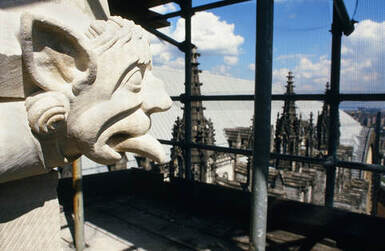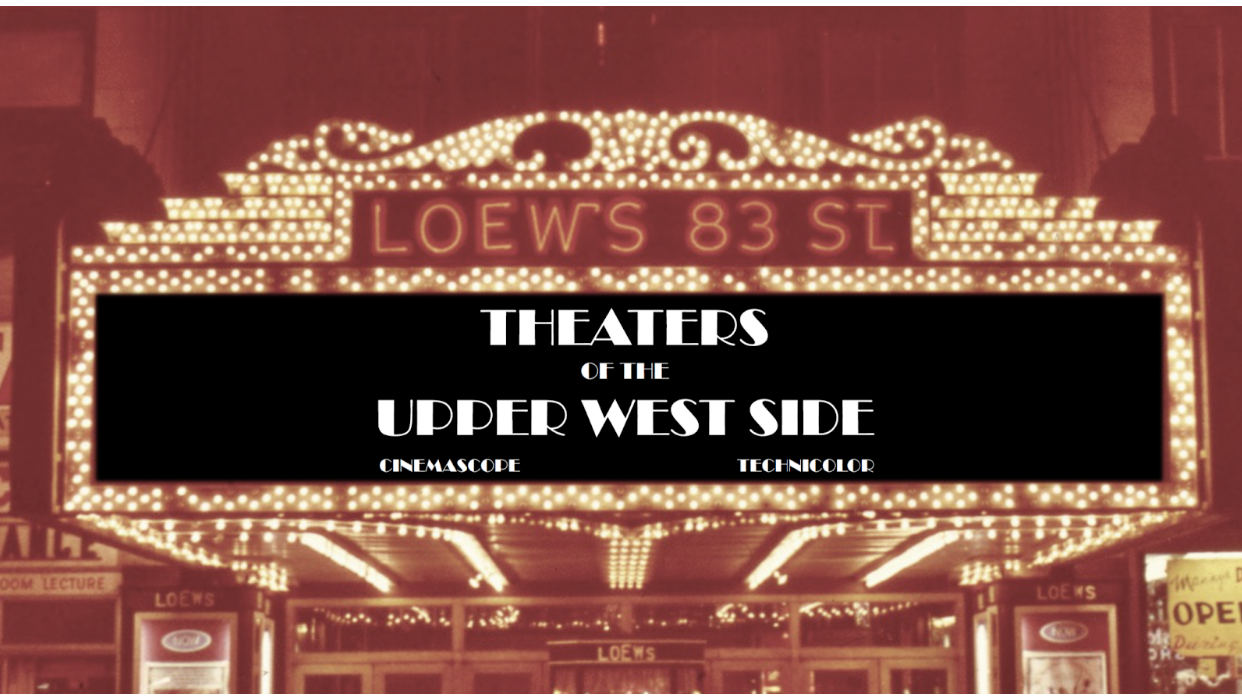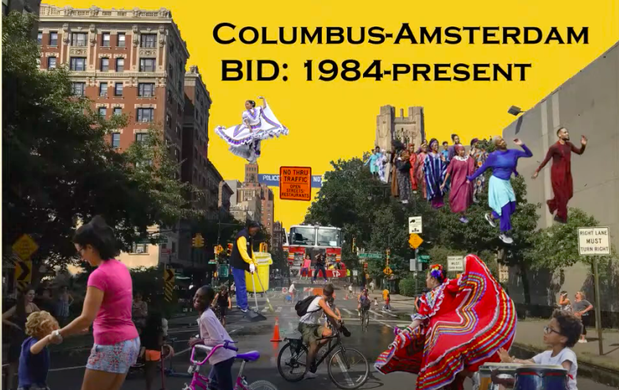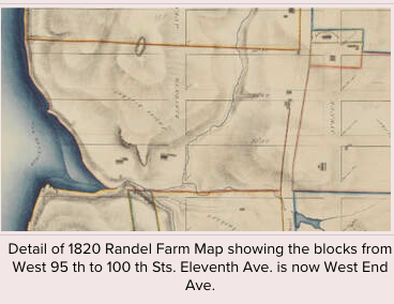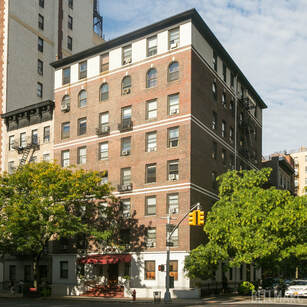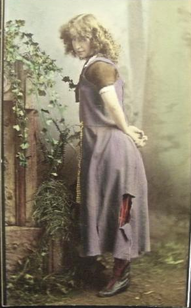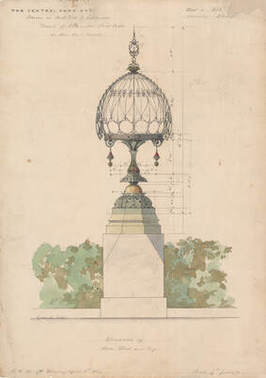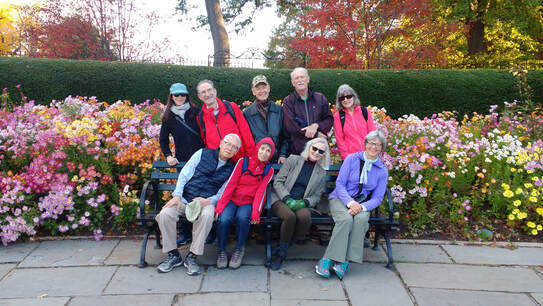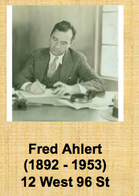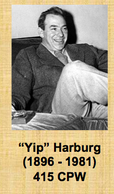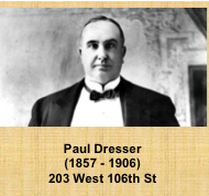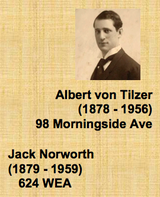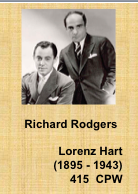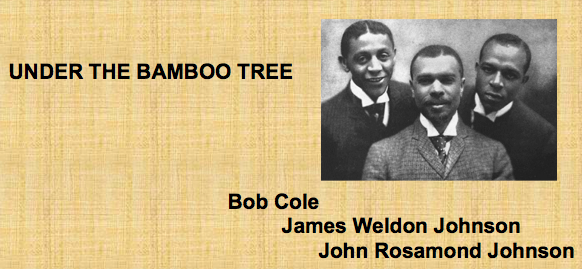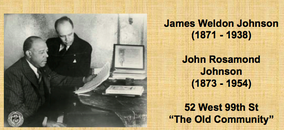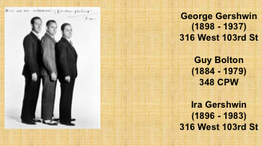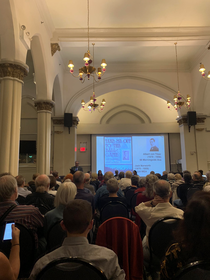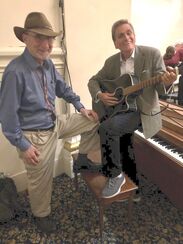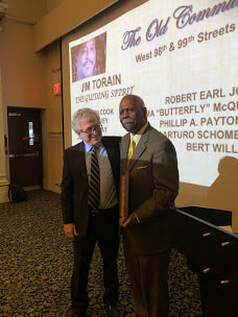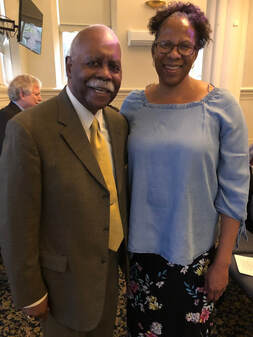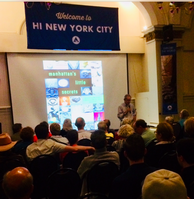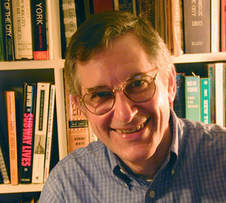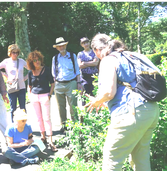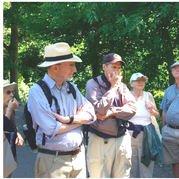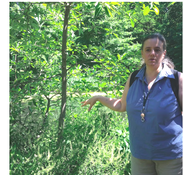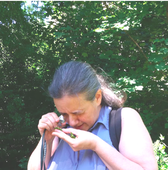PAST EVENTS 2024
Past Event Thursday, June 27th, 2024
"When Squatting Became Homesteading: Urban Renewal and Sweat Equity in Manhattan Valley"
presented by Jennifer Maya Luz Pliego
Watch the video of this presentation:
"When Squatting Became Homesteading: Urban Renewal and Sweat Equity in Manhattan Valley"
presented by Jennifer Maya Luz Pliego
Watch the video of this presentation:
The program: In the 1970s, low income families were trained to demolish and renovate abandoned buildings in Manhattan Valley. These same families became shareholders of their own homes in the newly renovated buildings. How their story evolved is an example of community engagement at its best.
The presenter: Jennifer Maya Luz Pliego is the creator of the portrait photo exhibition, Good Neighbors, at the Anibal Aviles Playground, 111 West 108th Street. She is a part of the leadership group of El Taller Latino Americano, a noteworthy arts, language and education organization, in its 45th year of service to New Yorkers.
The presenter: Jennifer Maya Luz Pliego is the creator of the portrait photo exhibition, Good Neighbors, at the Anibal Aviles Playground, 111 West 108th Street. She is a part of the leadership group of El Taller Latino Americano, a noteworthy arts, language and education organization, in its 45th year of service to New Yorkers.

Zoom Presentation Wednesday, May 15, 2024
"Before Central Park" presented by Sara Cedar Miller
Click HERE to watch video of this presentation
Central Park is an urban masterpiece. But before it became a model for city parks worldwide, the land was the site of farms, businesses, churches, wars, and burial grounds – and home to many different kinds of New Yorkers. In this program, Sara Cedar Miller chronicled two-and-a-half centuries of the history of that land: the 17th and 18th century Dutch and English landowners; three wars; the land divisions of the 19th century; New York’s Common Lands; the land that became Seneca Village, with new research on the landowners and renters of the Black community; the immigrant experience; the reservoirs; and lastly, the system behind the monetary awards to the landowners so the city could create Central Park.
Sara Cedar Miller has been the historian emerita of the Central Park Conservancy since 2017. She was the Conservancy photographer from 1984, and its historian from 1989 to 2017. Miller is the author of Central Park: An American Masterpiece (2003), Strawberry Fields, Central Park’s Memorial to John Lennon (2011), Seeing Central Park: The Official Guidebook: Updated and Expanded (2021) and Before Central Park (2022).
"Before Central Park" presented by Sara Cedar Miller
Click HERE to watch video of this presentation
Central Park is an urban masterpiece. But before it became a model for city parks worldwide, the land was the site of farms, businesses, churches, wars, and burial grounds – and home to many different kinds of New Yorkers. In this program, Sara Cedar Miller chronicled two-and-a-half centuries of the history of that land: the 17th and 18th century Dutch and English landowners; three wars; the land divisions of the 19th century; New York’s Common Lands; the land that became Seneca Village, with new research on the landowners and renters of the Black community; the immigrant experience; the reservoirs; and lastly, the system behind the monetary awards to the landowners so the city could create Central Park.
Sara Cedar Miller has been the historian emerita of the Central Park Conservancy since 2017. She was the Conservancy photographer from 1984, and its historian from 1989 to 2017. Miller is the author of Central Park: An American Masterpiece (2003), Strawberry Fields, Central Park’s Memorial to John Lennon (2011), Seeing Central Park: The Official Guidebook: Updated and Expanded (2021) and Before Central Park (2022).
Zoom Presentation Wednesday, April 3, 2024
Voices of the Stones: A Behind-the-Scenes Look at the Unfinished Tower of the Cathedral of St. John the Divine"
Presented by Robert F. Rodriguez, photojournalist and artist in residence at the Cathedral
Co-sponsored by the Bloomingdale Neighborhood History Group and the Columbus Amsterdam BID.
Voices of the Stones: A Behind-the-Scenes Look at the Unfinished Tower of the Cathedral of St. John the Divine"
Presented by Robert F. Rodriguez, photojournalist and artist in residence at the Cathedral
Co-sponsored by the Bloomingdale Neighborhood History Group and the Columbus Amsterdam BID.
Click on the photo above to watch the recording of this presentation
About the program:
Forty years ago, the Cathedral of St John the Divine undertook a major project to build its long overdue towers. Despite that effort, they were never completed – thus the church's nickname, St. John the Unfinished.
What most people don’t realize is that the partially built south tower is host to an extraordinary array of exquisite stone sculptures – not readily visible from street level.
Via a series of never-before-seen photographs, "Voices of the Stones" offers a unique, up-close-and-personal look at the wondrous, intricate and often humorous carvings, traces them back to the dedicated men and women stone carvers who created them, and reveals some “secret” messages they carved into their limestone creations.
About the presenter
As artist in residence at the Cathedral, photojournalist Robert F. Rodriguez spent more than 10 years documenting all facets of the construction work involved in building the tower. A photographer and photo editor at Gannett Newspapers for 38 years and The Daily Mail for ten, he was also the photographer for the book on local Upper West Side history, Heaven on the Hudson: Mansions, Monuments, and Marvels of Riverside Park, and the upcoming Fabulous Fountains of New York, both written by Stephanie Azzarone. His series of blogs about the Cathedral’s architecture may be found at https://divinestone.org/ .
Forty years ago, the Cathedral of St John the Divine undertook a major project to build its long overdue towers. Despite that effort, they were never completed – thus the church's nickname, St. John the Unfinished.
What most people don’t realize is that the partially built south tower is host to an extraordinary array of exquisite stone sculptures – not readily visible from street level.
Via a series of never-before-seen photographs, "Voices of the Stones" offers a unique, up-close-and-personal look at the wondrous, intricate and often humorous carvings, traces them back to the dedicated men and women stone carvers who created them, and reveals some “secret” messages they carved into their limestone creations.
About the presenter
As artist in residence at the Cathedral, photojournalist Robert F. Rodriguez spent more than 10 years documenting all facets of the construction work involved in building the tower. A photographer and photo editor at Gannett Newspapers for 38 years and The Daily Mail for ten, he was also the photographer for the book on local Upper West Side history, Heaven on the Hudson: Mansions, Monuments, and Marvels of Riverside Park, and the upcoming Fabulous Fountains of New York, both written by Stephanie Azzarone. His series of blogs about the Cathedral’s architecture may be found at https://divinestone.org/ .
ZOOM PRESENTATION Thursday, February 22, 2024
"The Lost Theaters of Broadway: An Upper West Side Story" Presented by Gary Dennis
Sponsored by the Bloomingdale Neighborhood History Group and the Columbus Amsterdam BID
To view a recording of this presentation, click HERE
"The Lost Theaters of Broadway: An Upper West Side Story" Presented by Gary Dennis
Sponsored by the Bloomingdale Neighborhood History Group and the Columbus Amsterdam BID
To view a recording of this presentation, click HERE
The program:
Whatever happened to all the theaters that were once on Broadway on the Upper West Side and the Bloomingdale neighborhood? In the late 1930s ,there were 13 of these theaters in operation and, though it’s hard to imagine now, there were once 31,000 theater seats between West 74th Street and 110th Streets.
Each of these theaters has since disappeared (with the exception of the Metro which is now just an empty shell) and each has its own unique story.
The presenter:
No one knows the stories of these movie palaces better than Upper West Sider Gary Dennis. Dennis is the expert on the subject, with extensive knowledge of the architects who designed the theaters, the films that played there and the role that each theater played in the life of the neighborhood.
Dennis was the owner of the Upper West Side’s beloved Movie Place, one of NYC’s original independent video stores and a longtime local favorite in Bloomingdale, with one of the most extensive film inventories in the country.
Whatever happened to all the theaters that were once on Broadway on the Upper West Side and the Bloomingdale neighborhood? In the late 1930s ,there were 13 of these theaters in operation and, though it’s hard to imagine now, there were once 31,000 theater seats between West 74th Street and 110th Streets.
Each of these theaters has since disappeared (with the exception of the Metro which is now just an empty shell) and each has its own unique story.
The presenter:
No one knows the stories of these movie palaces better than Upper West Sider Gary Dennis. Dennis is the expert on the subject, with extensive knowledge of the architects who designed the theaters, the films that played there and the role that each theater played in the life of the neighborhood.
Dennis was the owner of the Upper West Side’s beloved Movie Place, one of NYC’s original independent video stores and a longtime local favorite in Bloomingdale, with one of the most extensive film inventories in the country.
In Person and Zoom Presentation Monday, February 12, 2024
"An Island in Bloomingdale: Life in the Old Community"
presented by Susan Fridie and Rob Garber with introduction by Stephanie Azzarone
Evening included presentation of the "Jim Torain Award" to Andrew Alpern
"An Island in Bloomingdale: Life in the Old Community"
presented by Susan Fridie and Rob Garber with introduction by Stephanie Azzarone
Evening included presentation of the "Jim Torain Award" to Andrew Alpern
TAP HERE TO PLAY VIDEO OF THIS PRESENTATION
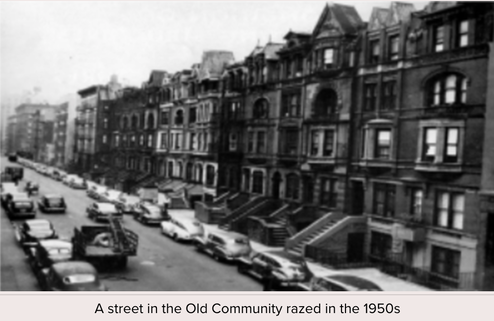
About the program:
In the opening years of the 20th century, a group of Black New Yorkers moved to West 98th and 99th Streets between Central Park West and Columbus Avenue. Restricted to two city blocks by discriminatory rental practices, their patch of Bloomingdale became a close-knit village that was home to 2,000-4,000 people of color for half a century. The Old Community, as it became known, was razed in the 1950s in the name of “urban renewal”. Amazingly, the former residents, though widely scattered by the destruction of their neighborhood, stayed connected for decades after its disappearance.
Timed to coincide with Black History Month, this presentation focused on the story of this unique community of color, its people, schools, social organizations, businesses and its remarkable afterlife. The evening featured Buddy Green, a long-time resident of the neighborhood, who shared his stories and answered audience questions.
In the opening years of the 20th century, a group of Black New Yorkers moved to West 98th and 99th Streets between Central Park West and Columbus Avenue. Restricted to two city blocks by discriminatory rental practices, their patch of Bloomingdale became a close-knit village that was home to 2,000-4,000 people of color for half a century. The Old Community, as it became known, was razed in the 1950s in the name of “urban renewal”. Amazingly, the former residents, though widely scattered by the destruction of their neighborhood, stayed connected for decades after its disappearance.
Timed to coincide with Black History Month, this presentation focused on the story of this unique community of color, its people, schools, social organizations, businesses and its remarkable afterlife. The evening featured Buddy Green, a long-time resident of the neighborhood, who shared his stories and answered audience questions.
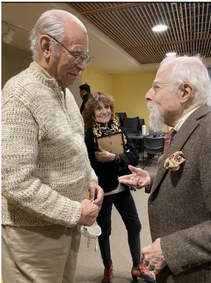 Buddy Green in conversation with Andrew Alpern. Marjorie Cohen in background.
Photo by Janet Mackin
Buddy Green in conversation with Andrew Alpern. Marjorie Cohen in background.
Photo by Janet Mackin
The award:
The "Jim Torain Award" acknowledges a person whose work honors the history of the Bloomingdale neighborhood. It is named for Jim Torain, who grew up in the Old Community and ensured that its legacy--its many talented and accomplished residents who enriched our local history--would not be forgotten.
On behalf of the BNHG, Marjorie Cohen presented the award to Andrew Alpern who has been a friend of the BNHG since he gave a talk for the group on the decoration of Upper West Side buildings that he included in his 11th book, Posh Portals: Elegant Entrances and Ingratiating Ingresses to Apartments for the Affluent in New York City. Alpern is an architectural historian, architect and attorney.
The "Jim Torain Award" acknowledges a person whose work honors the history of the Bloomingdale neighborhood. It is named for Jim Torain, who grew up in the Old Community and ensured that its legacy--its many talented and accomplished residents who enriched our local history--would not be forgotten.
On behalf of the BNHG, Marjorie Cohen presented the award to Andrew Alpern who has been a friend of the BNHG since he gave a talk for the group on the decoration of Upper West Side buildings that he included in his 11th book, Posh Portals: Elegant Entrances and Ingratiating Ingresses to Apartments for the Affluent in New York City. Alpern is an architectural historian, architect and attorney.
Zoom Presentation Wednesday, January 31, 2024
"Notable New Yorkers:of Bloomingdale: An Update" presented by local historian Jim Mackin
"Notable New Yorkers:of Bloomingdale: An Update" presented by local historian Jim Mackin
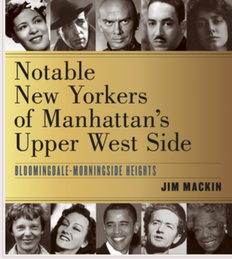
Jim Mackin-- local historian, popular tour guide, BNHG Planning Group member and author-- presented the second installment of the immensely popular program he put together for the BNHG three years ago. Jim’s presentation took a close look at some of the “notables” who once lived in the Bloomingdale neighborhood, the “wildly diverse people who shaped the character of the area.”
Jim spent years doing meticulous research for his book, Notable New Yorkers of Manhattan’s Upper West Side, published in 2021 by Fordham University Press and it is this book that was the inspiration for these presentations. Scouring hundreds of sources, he uncovered details of the lives of almost 600 one-time neighborhood residents-- some well known, others not-- which he included in his book. . (Actually, he found twice as many people who qualified but his publisher insisted on narrowing the number down to a more wieldy 600.)
Many of the lesser known subjects in the book are women: “My research revealed many surprises, including dozens of accomplished women whose histories are little known.”
Still engaged in research on the topic, Jim put together a richly illustrated presentation that marked the official start of BNHG’s 2024 season. His January 31st program delved into the lives of some new notables discovered since his first book came out and some of the interesting back stories that he uncovered along the way. He he discussed his new book, a follow up to the first, that’s in the works.
Jim spent years doing meticulous research for his book, Notable New Yorkers of Manhattan’s Upper West Side, published in 2021 by Fordham University Press and it is this book that was the inspiration for these presentations. Scouring hundreds of sources, he uncovered details of the lives of almost 600 one-time neighborhood residents-- some well known, others not-- which he included in his book. . (Actually, he found twice as many people who qualified but his publisher insisted on narrowing the number down to a more wieldy 600.)
Many of the lesser known subjects in the book are women: “My research revealed many surprises, including dozens of accomplished women whose histories are little known.”
Still engaged in research on the topic, Jim put together a richly illustrated presentation that marked the official start of BNHG’s 2024 season. His January 31st program delved into the lives of some new notables discovered since his first book came out and some of the interesting back stories that he uncovered along the way. He he discussed his new book, a follow up to the first, that’s in the works.
Past Events of 2023
"Meet the Artist: Neighborhood Resident Beatrice Coron Shares Her Work"
Thursday, November 30, 2023 in person at the Bloomingdale Public Library
Thursday, November 30, 2023 in person at the Bloomingdale Public Library
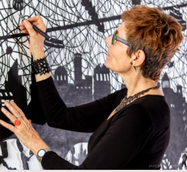
Beatrice Coron described her local art installation, her body of art, her working process, and her ties to the Bloomingdale neighborhood.
Coron is the creator of the eight art medallions, depicting local luminaries from the Bloomingdale neighborhood, now on view at the Happy Warrior Playground on Amsterdam Avenue between 97th and 98th Streets.
Coron studied art at the Ecole des Beaux-Arts of Lyon and Mandarin Chinese at the University of Lyon III. Her work includes illustrations, book art, fine art and public art.
Her characteristic silhouette designs are cut from paper and Tyvek. She has also created work in stone, glass, metal, rubber, stained glass and via digital media.
Calling herself a “visual storyteller,” Coron tells stories that “are about identities and transformations or how changes are inherent to a learning process, physically, spiritually or metaphorically.”
Coron’s public art can be seen in subways, airports, and sports facilities. Her work has been purchased by major museum collections, including the Metropolitan Museum, the Walker Art Center, and the Getty Center. Her TED talk, “Stories Cut from Paper” can be seen at https://www.ted.com/talks/beatrice_coron_stories_cut_from_paper?language=en
Coron is the creator of the eight art medallions, depicting local luminaries from the Bloomingdale neighborhood, now on view at the Happy Warrior Playground on Amsterdam Avenue between 97th and 98th Streets.
Coron studied art at the Ecole des Beaux-Arts of Lyon and Mandarin Chinese at the University of Lyon III. Her work includes illustrations, book art, fine art and public art.
Her characteristic silhouette designs are cut from paper and Tyvek. She has also created work in stone, glass, metal, rubber, stained glass and via digital media.
Calling herself a “visual storyteller,” Coron tells stories that “are about identities and transformations or how changes are inherent to a learning process, physically, spiritually or metaphorically.”
Coron’s public art can be seen in subways, airports, and sports facilities. Her work has been purchased by major museum collections, including the Metropolitan Museum, the Walker Art Center, and the Getty Center. Her TED talk, “Stories Cut from Paper” can be seen at https://www.ted.com/talks/beatrice_coron_stories_cut_from_paper?language=en
Thursday, October 12th, 2023
Video of the in-person BNHG presentation at the Bloomingdale Branch of the New York Public Library
"Honoring the Columbus Amsterdam Business Improvement District: A Brief History of an Exemplary Community Organization"
Video of the in-person BNHG presentation at the Bloomingdale Branch of the New York Public Library
"Honoring the Columbus Amsterdam Business Improvement District: A Brief History of an Exemplary Community Organization"
Throughout the years, one of the Bloomingdale Neighborhood History Group’s (BNHG) most influential and enthusiastic supporters has been the Columbus Amsterdam Business Improvement District (BID). It is no exaggeration to say that the BNHG could not have accomplished so much without the stalwart backing of the energetic and peripatetic Peter Arndtsten, retiring director of the BID.
To celebrate the work of the BID and Peter, BNHG hosted a program to honor the organization’s work, giving thanks to the Board of Directors and to Peter for their extraordinary contributions to life in this Upper West Side neighborhood.
The program was in-person at the Bloomingdale Library (another terrific supporter of the BNHG’s work.) Peter gave a survey of the history of the BID and its influence on this slice of Manhattan during the BID's almost four decades of existence.
The BID’s storefront, with its bright yellow awning on Amsterdam Avenue between 108th and 109th Streets, is where staff and interns work, planning how to increase commercial activity and create a more vital and active business center along Columbus and Amsterdam Avenues, from 96th to 110th Streets. Working tirelessly over the years, they have made the neighborhood cleaner, safer, and more prosperous while partnering in the work of the BNHG, discovering, preserving and sharing the history of the neighborhood.
To celebrate the work of the BID and Peter, BNHG hosted a program to honor the organization’s work, giving thanks to the Board of Directors and to Peter for their extraordinary contributions to life in this Upper West Side neighborhood.
The program was in-person at the Bloomingdale Library (another terrific supporter of the BNHG’s work.) Peter gave a survey of the history of the BID and its influence on this slice of Manhattan during the BID's almost four decades of existence.
The BID’s storefront, with its bright yellow awning on Amsterdam Avenue between 108th and 109th Streets, is where staff and interns work, planning how to increase commercial activity and create a more vital and active business center along Columbus and Amsterdam Avenues, from 96th to 110th Streets. Working tirelessly over the years, they have made the neighborhood cleaner, safer, and more prosperous while partnering in the work of the BNHG, discovering, preserving and sharing the history of the neighborhood.
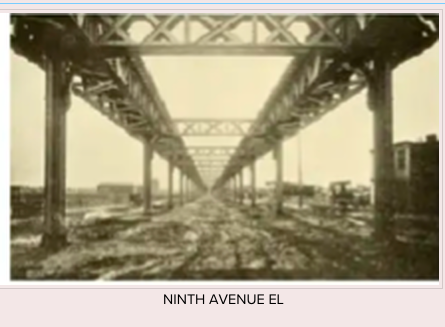
Zoom Presentation
"Building the Metropolis", Presented by Alexander Wood
Wednesday, September 27, 2023
Co-sponsored by the Columbus Amsterdam BID and the Bloomingdale Neighborhood History Group (BNHG).
"Building the Metropolis", Presented by Alexander Wood
Wednesday, September 27, 2023
Co-sponsored by the Columbus Amsterdam BID and the Bloomingdale Neighborhood History Group (BNHG).
The program: In the late nineteenth century, New York’s rapid growth created a new urban landscape, turned construction into big business, and revitalized the building trades. This illustrated talk covered the technological changes that transformed construction, the importance of the building industry to the city’s economy, and the role played by contractors and construction workers in the politics of the time.

The presenter: Alexander Wood is an architectural and urban historian. He received his Ph.D. from Columbia University and his B. Arch. from Cooper Union. In 2021-22 he was the Helen and Robert Appel Fellow in History and Technology at the New-York Historical Society.
Zoom Presentation May 11, 2023
"The Paterno Buildings in Bloomingdale: An Immigrant Family’s Contribution to the Upper West Side"
presented by Carla Paterno Golden
"The Paterno Buildings in Bloomingdale: An Immigrant Family’s Contribution to the Upper West Side"
presented by Carla Paterno Golden
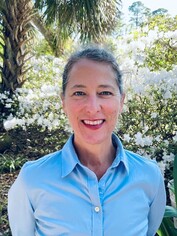 Carla Golden
Carla Golden
The Paterno Family immigrated to New York City from Castelmezzano, Italy, in 1880, and subsequently built 164 buildings in Manhattan, mostly apartment houses. Of those, 95% still stand. The family was responsible for 32 buildings in Bloomingdale alone.
Carla Golden, great-granddaughter of Dr. Charles V. Paterno, introduced us to those Bloomingdale buildings, shared the stories behind them, along with an enchanting tale of immigration involving one of Manhattan’s most prolific building families.
Carla Golden started researching her family and their architectural legacy three years ago and has—for the first time in history—cataloged, researched, and photographed all of her family’s known buildings. The Paterno story is one of many immigrant stories – a tale of achieving the American Dream—but unique in character due to both the arrival and success of the Paterno family being purely accidental.
Click this link to the Paterno Archives on our website
Carla Golden, great-granddaughter of Dr. Charles V. Paterno, introduced us to those Bloomingdale buildings, shared the stories behind them, along with an enchanting tale of immigration involving one of Manhattan’s most prolific building families.
Carla Golden started researching her family and their architectural legacy three years ago and has—for the first time in history—cataloged, researched, and photographed all of her family’s known buildings. The Paterno story is one of many immigrant stories – a tale of achieving the American Dream—but unique in character due to both the arrival and success of the Paterno family being purely accidental.
Click this link to the Paterno Archives on our website
Zoom Presentation April 20, 2023
"The Maps That Made Manhattan: The History and Role of the Manhattan Topographical Bureau"
presented by Hector Rivera
"The Maps That Made Manhattan: The History and Role of the Manhattan Topographical Bureau"
presented by Hector Rivera
Zoom Presentation February 23, 2023
"From the Pacific Northwest to the Upper West Side: The Lumber that Built Our Blocks--Where It Came from, How It Got Here and How It’s Being Recycled"
Presented by Alan Solomon, co-author of Reclaimed Wood: A Field Guide
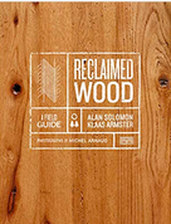
About the program: As Alan Solomon writes in his fascinating book on Reclaimed Wood, “A late nineteenth century urban row house can reveal a mix of woods as diverse as the immigrants it sheltered.” Solomon originally planned to zoom his talk from his showroom in Brooklyn, but a trip north to examine the wood in a 19th century toy factory headed for demolition caused a change of plans when a snowstorm hit the area. From his hotel room in Massachusetts, Solomon explained the fascinating stories of the varied types of lumber used in local homes and factories. He talked about the species, forest sources, logging and transport methods that brought these woods across the country to the Upper West Side. He focused on a Columbus Avenue building, an example of his belief that “every building tells a story about the growth and development of our city”.
Moving on to the present day, he explained why old lumber and its recovery matters, about its reuse applications and about some of the interesting recent work by the tree ring lab at Columbia University, which is using salvaged lumber to research climate change.
Moving on to the present day, he explained why old lumber and its recovery matters, about its reuse applications and about some of the interesting recent work by the tree ring lab at Columbia University, which is using salvaged lumber to research climate change.
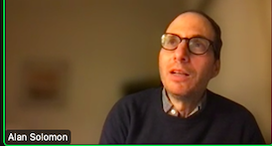
About the presenter: Alan Solomon is the co-author of Reclaimed Wood: A Field Guide, published by Abrams. He is not only an expert on the subject of all things wood but is also a partner in Sawkill Lumber LLC, https://www.sawkill.nyc/ a company that specializes in supplying reclaimed wood for both residential and commercial uses.
He initiated an extraordinary preservation campaign for an 1832 warehouse at 211 Pearl Street in Manhattan that was profiled in the New Yorker magazine. https://www.newyorker.com/magazine/2008/01/07/mystery-on-pearl-street
A program of the Bloomingdale Neighborhood History Group and the Columbus/Amsterdam BID
He initiated an extraordinary preservation campaign for an 1832 warehouse at 211 Pearl Street in Manhattan that was profiled in the New Yorker magazine. https://www.newyorker.com/magazine/2008/01/07/mystery-on-pearl-street
A program of the Bloomingdale Neighborhood History Group and the Columbus/Amsterdam BID
"The Joys (and How-Tos) of Researching Neighborhood History"
Wednesday, February 8, 2022
In-person and free at the Bloomingdale Branch of the New York Public Library
|
Pam Tice, one of the presenters and a member of the BNHG Planning Committee, has compiled a 4-page downloadable and printable list of useful references for your own historical research.
| ||||||
The evening's program presenters--Jim Mackin, Pam Tice, Vita Wallace and other members of the Bloomingdale Neighborhood History Group (BNHG)--were on hand to inform and guide beginners who were introduced to the library's neighborhood history collection. Participants received tips on how to use the collection and other sources for their own research.
The BNHG, which focuses on, but is not limited to the neighborhood between West 96th and 110th Streets, has been presenting regularly scheduled walks and talks for more than two decades. Its members established the neighborhood history collection at the Bloomingdale branch library in 2003. This event celebrates the ongoing collaboration of this unique volunteer group and the library and is the perfect opportunity to introduce this easy-to-use resource to a wider community.
Stories chosen for the occasion focused on long-forgotten medical institutions in the neighborhood, including the New York Cancer Hospital which is pictured in the accompanying photograph. The evening’s speakers inspired neighbors to pursue their curiosity about the history of the area. To do this, suggested a wide variety of strategies to explore, while sharing a wealth of information that they’ve collected about some of the specific tools and sources available both on the internet and around the city.
The BNHG, which focuses on, but is not limited to the neighborhood between West 96th and 110th Streets, has been presenting regularly scheduled walks and talks for more than two decades. Its members established the neighborhood history collection at the Bloomingdale branch library in 2003. This event celebrates the ongoing collaboration of this unique volunteer group and the library and is the perfect opportunity to introduce this easy-to-use resource to a wider community.
Stories chosen for the occasion focused on long-forgotten medical institutions in the neighborhood, including the New York Cancer Hospital which is pictured in the accompanying photograph. The evening’s speakers inspired neighbors to pursue their curiosity about the history of the area. To do this, suggested a wide variety of strategies to explore, while sharing a wealth of information that they’ve collected about some of the specific tools and sources available both on the internet and around the city.
Past Events of 2022
Zoom Presentation, Wednesday, November 30, 2022
"Down by Riverside: the Park, the Drive and Bloomingdale"
with author Stephanie Azzarone
"Down by Riverside: the Park, the Drive and Bloomingdale"
with author Stephanie Azzarone
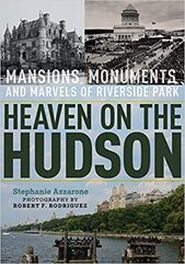
About the program:
Riverside Park and Riverside Drive have lived many lives. Originally Native American hunting grounds, over time the neighborhood was also the site of vast farms, elegant country estates and stunning millionaires’ villas. Many of the first homes on the Drive arose in the Bloomingdale neighborhood.
"Down by Riverside: the Park, the Drive and Bloomingdale" looked at the creation and evolution of Park and Drive through the eyes of the individuals responsible for it: the powerful men who conceived it, promoted it and pioneered life along it. Their goal: to create “the city’s preeminent residential street, expected to eclipse Fifth Avenue with ease.”
While some of their names are well known, others have been long forgotten. This presentation revealed who they were and shared their stories – from tales of murder to fears of being buried alive -- while focusing on the families who lived in Bloomingdale both before and after the Park and Drive came to be.
Riverside Park and Riverside Drive have lived many lives. Originally Native American hunting grounds, over time the neighborhood was also the site of vast farms, elegant country estates and stunning millionaires’ villas. Many of the first homes on the Drive arose in the Bloomingdale neighborhood.
"Down by Riverside: the Park, the Drive and Bloomingdale" looked at the creation and evolution of Park and Drive through the eyes of the individuals responsible for it: the powerful men who conceived it, promoted it and pioneered life along it. Their goal: to create “the city’s preeminent residential street, expected to eclipse Fifth Avenue with ease.”
While some of their names are well known, others have been long forgotten. This presentation revealed who they were and shared their stories – from tales of murder to fears of being buried alive -- while focusing on the families who lived in Bloomingdale both before and after the Park and Drive came to be.
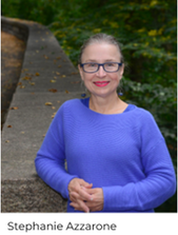
About the presenter:
Stephanie Azzarone is the author of the new book, Heaven on the Hudson: Mansions, Monuments, and Marvels of Riverside Park, and a member of the Bloomingdale Neighborhood History Group Planning Committee. She has also presented histories of Riverside Park and Drive for Landmark West! and the Municipal Art Society. A native New Yorker and an Upper West Sider who has lived on Riverside Drive most of her life, Stephanie has spent many joyous hours learning about New York history and architecture. A former journalist (freelancer for The New York Times and New York magazine, among others), she also ran an award-winning Manhattan public relations agency. Currently, she is studying for her tour guide certification with the goal of sharing her knowledge of Upper West Side life along the Hudson River with natives and tourists alike. A graduate of New York University, Stephanie has a degree in Journalism.
Stephanie Azzarone is the author of the new book, Heaven on the Hudson: Mansions, Monuments, and Marvels of Riverside Park, and a member of the Bloomingdale Neighborhood History Group Planning Committee. She has also presented histories of Riverside Park and Drive for Landmark West! and the Municipal Art Society. A native New Yorker and an Upper West Sider who has lived on Riverside Drive most of her life, Stephanie has spent many joyous hours learning about New York history and architecture. A former journalist (freelancer for The New York Times and New York magazine, among others), she also ran an award-winning Manhattan public relations agency. Currently, she is studying for her tour guide certification with the goal of sharing her knowledge of Upper West Side life along the Hudson River with natives and tourists alike. A graduate of New York University, Stephanie has a degree in Journalism.
Zoom Presentation Thursday, September 29, 2022
"Vanished Waters: The Old Springs, Wells and Watercourses of Bloomingdale"
with presenters Jim Mackin and Gil Tauber
Presentation of the "Jim Torain Award" to Robert Snyder
"Vanished Waters: The Old Springs, Wells and Watercourses of Bloomingdale"
with presenters Jim Mackin and Gil Tauber
Presentation of the "Jim Torain Award" to Robert Snyder
About the Program
It’s very possible that there’s a stream running under the basement of the your building. Or that there was once a well at the corner of your block. (See the photo above.) Streams and ponds covered our landscape before it was transformed by pavement and buildings in the late 19 th and early 20 th centuries.
Some 120 years ago, James Ruell Smith, an interesting fellow with a camera and a bicycle, found and documented every spring and well in the area. Gil Tauber and Jim Mackin covered all this and much more in this illustrated presentation created especially for the Bloomingdale Neighborhood History Group (BNHG).
About the Presenters:
Jim Mackin is a New York City historian, founder of WeekdayWalks https://www.weekdaywalks.com/, which provides history tours of New York neighborhoods, and is most recently the author of Notable New Yorkers of Manhattan’s Upper West Side. He’s a long-time member of the Bloomingdale Neighborhood History Group planning committee, and the recipient of the Mayor’s Award for Volunteer Service and the Morningside Heights Historic District Committee Award for his
contributions to the community. Jim leads a popular series of monthly walks focused on the Upper West Side co-sponsored by BNHG and theColumbus Amsterdam BID.
Gil Tauber, also a member of the BNHG, is a retired urban planner, and environmental consultant. He is the primary researcher of the building database on the BNHG website that lists all of the approximately 1,056 buildings on the West Side between 96 th and 110 th Streets. He is also the creator of two websites on New York City street names, www.oldstreets.com about former names of Manhattan streets; and www.nycstreets.info about the numerous honorary or secondary street names in the five boroughs.
About the Jim Torain Award
The annual Torain Award: Since 2018, (with a hiatus in 2020 for the pandemic) the Bloomingdale Neighborhood History Group (BNHG) has honored the memory of former member, Jim Torain, with the Torain Award. This year’s award is going to Snyder for the impressive work he has done to help share and promote local history throughout Manhattan and especially for the generous assistance he has given with a number of the
BNHG’s projects.
About Jim Torain:
Jim spent most of his life working tirelessly to preserve the legacy of the Old Community where he grew up. The Old Community isthe name given to the African American neighborhood that flourished on West 98th and West 99th Street between Central Park West and ColumbusAvenue--a neighborhood that was destroyed in the mid 1950s as part of the city's urban renewal plan. Without Torain's work, the history of this vibrant neighborhood, once the home of so many talented and accomplished New Yorkers, might have been lost to time.
It’s very possible that there’s a stream running under the basement of the your building. Or that there was once a well at the corner of your block. (See the photo above.) Streams and ponds covered our landscape before it was transformed by pavement and buildings in the late 19 th and early 20 th centuries.
Some 120 years ago, James Ruell Smith, an interesting fellow with a camera and a bicycle, found and documented every spring and well in the area. Gil Tauber and Jim Mackin covered all this and much more in this illustrated presentation created especially for the Bloomingdale Neighborhood History Group (BNHG).
About the Presenters:
Jim Mackin is a New York City historian, founder of WeekdayWalks https://www.weekdaywalks.com/, which provides history tours of New York neighborhoods, and is most recently the author of Notable New Yorkers of Manhattan’s Upper West Side. He’s a long-time member of the Bloomingdale Neighborhood History Group planning committee, and the recipient of the Mayor’s Award for Volunteer Service and the Morningside Heights Historic District Committee Award for his
contributions to the community. Jim leads a popular series of monthly walks focused on the Upper West Side co-sponsored by BNHG and theColumbus Amsterdam BID.
Gil Tauber, also a member of the BNHG, is a retired urban planner, and environmental consultant. He is the primary researcher of the building database on the BNHG website that lists all of the approximately 1,056 buildings on the West Side between 96 th and 110 th Streets. He is also the creator of two websites on New York City street names, www.oldstreets.com about former names of Manhattan streets; and www.nycstreets.info about the numerous honorary or secondary street names in the five boroughs.
About the Jim Torain Award
The annual Torain Award: Since 2018, (with a hiatus in 2020 for the pandemic) the Bloomingdale Neighborhood History Group (BNHG) has honored the memory of former member, Jim Torain, with the Torain Award. This year’s award is going to Snyder for the impressive work he has done to help share and promote local history throughout Manhattan and especially for the generous assistance he has given with a number of the
BNHG’s projects.
About Jim Torain:
Jim spent most of his life working tirelessly to preserve the legacy of the Old Community where he grew up. The Old Community isthe name given to the African American neighborhood that flourished on West 98th and West 99th Street between Central Park West and ColumbusAvenue--a neighborhood that was destroyed in the mid 1950s as part of the city's urban renewal plan. Without Torain's work, the history of this vibrant neighborhood, once the home of so many talented and accomplished New Yorkers, might have been lost to time.
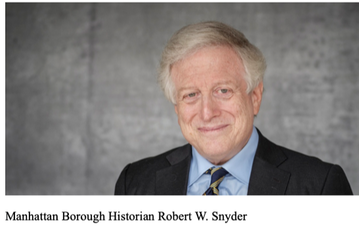
About Robert W. Snyder:
Manhattan Borough Historian Snyder is professor emeritus of Journalism and American Studies at Rutgers University. He has devoted his career to writing and teaching about the history of New York City. Currently editing a documentary history of the Covid pandemic in New York City, he has written for both scholars and the general public in books such as Crossing Broadway: Washington Heights and the Promise of New York and All the Nations Under Heaven: Immigrants, Migrants and the Making of New York. To share history with a broad public he has worked with the Smithsonian Institution, National Public Radio and the Museum of the City of New York and published essays in the New York Times, the Washington Post, The Conversation and Platform. He was a Fulbright lecturer in American Studies in Korea and is a member of the New York Academy History. He lives in Manhattan.
Manhattan Borough Historian Snyder is professor emeritus of Journalism and American Studies at Rutgers University. He has devoted his career to writing and teaching about the history of New York City. Currently editing a documentary history of the Covid pandemic in New York City, he has written for both scholars and the general public in books such as Crossing Broadway: Washington Heights and the Promise of New York and All the Nations Under Heaven: Immigrants, Migrants and the Making of New York. To share history with a broad public he has worked with the Smithsonian Institution, National Public Radio and the Museum of the City of New York and published essays in the New York Times, the Washington Post, The Conversation and Platform. He was a Fulbright lecturer in American Studies in Korea and is a member of the New York Academy History. He lives in Manhattan.
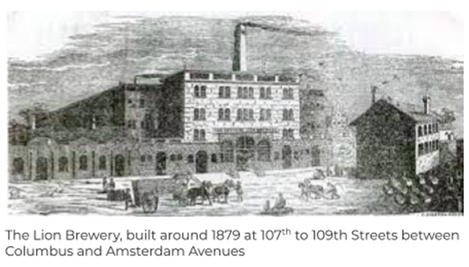
HOMEMADE HISTORY EXCHANGES
Sunday, August 14 and Oct 16, 2022
from 1:00 to 4:00
Amsterdam Ave & 109th Street
Sunday, August 14 and Oct 16, 2022
from 1:00 to 4:00
Amsterdam Ave & 109th Street
During the pandemic, it's been easier to stay in touch with long-time followers than to meet new people, so a welcome aspect of our recent outdoor in-person event was serendipity: neighbors could bump into us again. With the help of the Columbus-Amsterdam Business Improvement District, the guardian angels of weekly Open Streets, we set up several tents and tables on 109th and Amsterdam. It was a beautiful cool and sunny day.
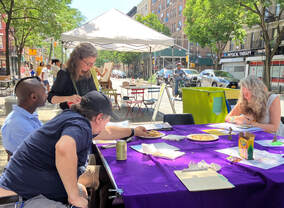 Photo by Stephanie Azzarone
Photo by Stephanie Azzarone
You could browse display boards and pick up flyers and maps to take home. Next to the flyer table was a "reading room," a big square table. Upon the table were many paths into the history and our group's 22 years of collected knowledge. You might begin by looking up your address in Gil Tauber’s Building Database, then go on to read Pam Tice's Blogs, pore over materials from our Library Collection (chosen for their relevance to the block we were on), and read booklets from the collection on Fire Department history, our local subway stations, the Bloomingdale Conservation Project, the Manhattan Avenue Historic District, and How to Research Your Building, as well as Jim Mackin’s book “Notable New Yorkers of Manhattan’s Upper West Side.” Readers enjoyed homemade cookies, took pictures of certain pages, and leant over to show each other especially interesting bits.
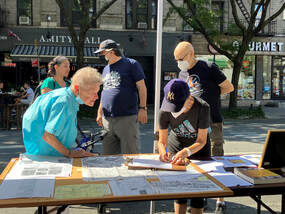 Photo by Stephanie Azzarone
Photo by Stephanie Azzarone
Another avenue into the history was to talk with the many members of our planning committee who were there. I highlighted the Lion Brewery (just because it was where we were sitting, and it's invisible to the naked eye now!) and the brewery’s big fire of July 4, 1927 (because it was spectacular and we had a picture).
Peter Arndtsen reported that the Homemade History Exchange “was a tremendously engaging event that brought out and together a variety of the neighborhood!” In addition to passersby, a lot of folks came specifically for the event. A few brought materials for our library collection, but many others clearly brought knowledge to share. A warm welcome to those of you who just joined our mailing list! As Win Armstrong remarked, the day was “both a catharsis and a stimulus;” may the lively exchange of knowledge continue, in a variety of happy forms!
Peter Arndtsen reported that the Homemade History Exchange “was a tremendously engaging event that brought out and together a variety of the neighborhood!” In addition to passersby, a lot of folks came specifically for the event. A few brought materials for our library collection, but many others clearly brought knowledge to share. A warm welcome to those of you who just joined our mailing list! As Win Armstrong remarked, the day was “both a catharsis and a stimulus;” may the lively exchange of knowledge continue, in a variety of happy forms!
Read an article from the West Side Spirit on the History Exchange and the BNHG's own history
https://www.westsidespirit.com/news/the-old-bloomingdale-neighborhood-DA2174342
https://www.westsidespirit.com/news/the-old-bloomingdale-neighborhood-DA2174342
Zoom Presentation, Monday, June 13, 2022
"From Tidal Marsh to Idyllic Retreat: The Story of Central Park’s Harlem Meer"
with Lane Addonizio, VP for Planning at the Central Park Conservancy
"From Tidal Marsh to Idyllic Retreat: The Story of Central Park’s Harlem Meer"
with Lane Addonizio, VP for Planning at the Central Park Conservancy
The Program:
In 1853, when the New York State legislature authorized the acquisition of the land that would become Central Park, the site did not include the 66-acre stretch between 106th and 110th Streets that contains the Harlem Meer at the present-day northeast corner of the Park. The tidal marsh that would ultimately be transformed into the Meer (Dutch for “Lake”) was acquired several years into the Park’s construction, along with the rocky, fortification-dotted bluffs overlooking Harlem that would become the Park’s Fort Landscape and part of the North Woods.
The natural and pre-park history of the Meer site, its incorporation by Frederick Law Olmsted and Calvert Vaux into their design of the Park, the changes it has seen through the course of the Park’s history, and the vision looking ahead to the completion of work now underway—all contribute to the fascinating and richly-layered story of this remarkable landscape and what it means to the communities that cherish it.
In 1853, when the New York State legislature authorized the acquisition of the land that would become Central Park, the site did not include the 66-acre stretch between 106th and 110th Streets that contains the Harlem Meer at the present-day northeast corner of the Park. The tidal marsh that would ultimately be transformed into the Meer (Dutch for “Lake”) was acquired several years into the Park’s construction, along with the rocky, fortification-dotted bluffs overlooking Harlem that would become the Park’s Fort Landscape and part of the North Woods.
The natural and pre-park history of the Meer site, its incorporation by Frederick Law Olmsted and Calvert Vaux into their design of the Park, the changes it has seen through the course of the Park’s history, and the vision looking ahead to the completion of work now underway—all contribute to the fascinating and richly-layered story of this remarkable landscape and what it means to the communities that cherish it.
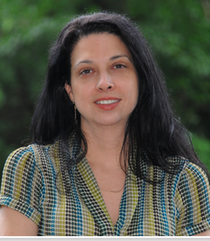
The Presenter:
As Vice President for Planning at the Central Park Conservancy, Lane Addonizio oversees research and analysis for parkwide and project planning and participates in the leadership of the Conservancy’s Planning, Design, and Construction team that is responsible for the Park’s ongoing restoration and reconstruction.
Ms. Addonizio is a city planner with experience in public space improvement, historic preservation, open space conservation, and community revitalization.
She is the author of the Report on the Public Use of Central Park, the most comprehensive study of the Park’s use in its more than 150-year history,and a co-author of Plan for Play: A Framework for Rebuilding and Managing Central Park’s Playgrounds, both of which were published by the Conservancy in 2011.
As Vice President for Planning at the Central Park Conservancy, Lane Addonizio oversees research and analysis for parkwide and project planning and participates in the leadership of the Conservancy’s Planning, Design, and Construction team that is responsible for the Park’s ongoing restoration and reconstruction.
Ms. Addonizio is a city planner with experience in public space improvement, historic preservation, open space conservation, and community revitalization.
She is the author of the Report on the Public Use of Central Park, the most comprehensive study of the Park’s use in its more than 150-year history,and a co-author of Plan for Play: A Framework for Rebuilding and Managing Central Park’s Playgrounds, both of which were published by the Conservancy in 2011.
Zoom Presentation, Wednesday, April 27, 2022
"More than Cherries: The Flowering Trees of Riverside Park"
with Margaret Bracken, Landscape Architect for Riverside Park
"More than Cherries: The Flowering Trees of Riverside Park"
with Margaret Bracken, Landscape Architect for Riverside Park
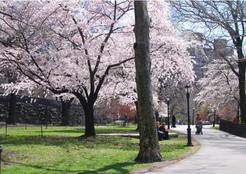
For those of us on the Upper West Side, nothing signals the coming of spring like the blooming of the much-beloved crabapple and cherry trees in Riverside Park. What better way to welcome the season than to hear all about these trees and the horticultural history of the park from Margaret Bracken who has been the Landscape Architect for Riverside Park for almost two decades.
Bracken chose a perfect date for her presentation--just one day after the 100th birthday of Frederick Law Olmsted, Sr., the creator of the original schematic design of our beautiful waterfront park.
One of the first things we learned from Bracken is that what we often think of as the park’s cherry trees are actually crab apple trees. Bracken also talked about the history of the trees in Morningside Heights’s Sakura Park, trees that were a gift from the Japanese government to the city at the beginning of the 20th century.
Bracken chose a perfect date for her presentation--just one day after the 100th birthday of Frederick Law Olmsted, Sr., the creator of the original schematic design of our beautiful waterfront park.
One of the first things we learned from Bracken is that what we often think of as the park’s cherry trees are actually crab apple trees. Bracken also talked about the history of the trees in Morningside Heights’s Sakura Park, trees that were a gift from the Japanese government to the city at the beginning of the 20th century.
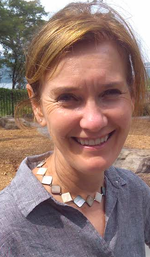
About the presenter: Margaret Bracken is the landscape architect for Riverside Park. As the sole design professional for the park, she is involved in all design, construction and horticulture throughout the 327 acre park. Her design projects include Soldiers and Sailors Monument Plaza at West 87th Street; the historic granite entry stairs-- the Carrere Stairs-- at West 99th Street; the restoration of the Robert Ray Hamilton Fountain at West 76th Street; multiple dog runs and playgrounds; and small scale infrastructure repairs.
She has worked on everything from huge projects with a budget of $150,000,000 such as the Rotunda at West 79th Street to the everyday repairs that keep the park in working order, such as replacing sewer covers and fixing fences. And she is a consummate diplomat, having won praise for her handling of the controversial 108th Street skate park project before the required Community Board 7 approval meeting, described by a local newspaper as a "love fest for Margaret Bracken."
She has worked on everything from huge projects with a budget of $150,000,000 such as the Rotunda at West 79th Street to the everyday repairs that keep the park in working order, such as replacing sewer covers and fixing fences. And she is a consummate diplomat, having won praise for her handling of the controversial 108th Street skate park project before the required Community Board 7 approval meeting, described by a local newspaper as a "love fest for Margaret Bracken."
Zoom Presentation, Wednesday, March 16, 2022
"Stained Glass Stories: Tiffany (and More) in the Bloomingdale Neighborhood"
Presented by Julie L. Sloan, consultant, author, professor and appraiser
"Stained Glass Stories: Tiffany (and More) in the Bloomingdale Neighborhood"
Presented by Julie L. Sloan, consultant, author, professor and appraiser
Bloomingdale and its surrounding neighborhood are home to two of Tiffany Studios’ most spectacular windows, one in St. Michael’s Episcopal Church on West 99th Street and Amsterdam Avenue and the other at the Lutheran Church of the Advent on Broadway and West 93rd Street.
Another of Tiffany’s famous works, the Columbian Chapel, made for the 1893 World’s Columbian Exposition in Chicago, was once housed in the Cathedral of St. John the Divine and the area’s only window by John La Farge, Tiffany’s principal competitor, is located only a few blocks from Bloomingdale in Columbia University’s St. Paul’s Chapel.
The Bloomingdale Neighborhood History Group invited Julie L. Sloan, one of the country’s most qualified stained-glass experts, to tell the stories of these spectacular windows. She touched on the background of some of the other notable windows that can be found in or around Bloomingdale.
Another of Tiffany’s famous works, the Columbian Chapel, made for the 1893 World’s Columbian Exposition in Chicago, was once housed in the Cathedral of St. John the Divine and the area’s only window by John La Farge, Tiffany’s principal competitor, is located only a few blocks from Bloomingdale in Columbia University’s St. Paul’s Chapel.
The Bloomingdale Neighborhood History Group invited Julie L. Sloan, one of the country’s most qualified stained-glass experts, to tell the stories of these spectacular windows. She touched on the background of some of the other notable windows that can be found in or around Bloomingdale.
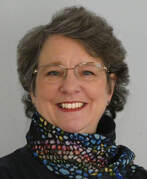
About the presenter:
Sloan has been a stained-glass consultant since 1984, specializing in conservation studies, conservation management, and history. Her conservation projects include Saint Thomas Episcopal Church, New York; H. H. Richardson’s Trinity Church in Boston; Harvard University’s Memorial Hall; Trinity Church, Wall Street; The Riverside Church in New York; and Princeton University’s Chapel. She served as adjunct professor of historic preservation at Columbia University from 1985 to 2013; has lectured at Salve Regina University in Newport, RI, Williams College, and Rensselaer Polytechnic Institute; and has given seminars and lectures all around the United States.
Author of Conservation of Stained Glass in America (Art in Architecture Press, 1995), she has written many articles on both stained-glass history and conservation. Her other books include Light Screens: The Complete Leaded-Glass Windows of Frank Lloyd Wright (Rizzoli International,2000); Frederic Crowninshield: A Renaissance Man in the Gilded Age (University of Massachusetts Press, 2010) with Gertrude deG. Wilmers, the artist’s great-granddaughter; and The Berkshire Glass Works (The History Press, 2011) with William Patriquin. At the moment, she is at work on a comprehensive history of American stained glass.
Sloan has been a stained-glass consultant since 1984, specializing in conservation studies, conservation management, and history. Her conservation projects include Saint Thomas Episcopal Church, New York; H. H. Richardson’s Trinity Church in Boston; Harvard University’s Memorial Hall; Trinity Church, Wall Street; The Riverside Church in New York; and Princeton University’s Chapel. She served as adjunct professor of historic preservation at Columbia University from 1985 to 2013; has lectured at Salve Regina University in Newport, RI, Williams College, and Rensselaer Polytechnic Institute; and has given seminars and lectures all around the United States.
Author of Conservation of Stained Glass in America (Art in Architecture Press, 1995), she has written many articles on both stained-glass history and conservation. Her other books include Light Screens: The Complete Leaded-Glass Windows of Frank Lloyd Wright (Rizzoli International,2000); Frederic Crowninshield: A Renaissance Man in the Gilded Age (University of Massachusetts Press, 2010) with Gertrude deG. Wilmers, the artist’s great-granddaughter; and The Berkshire Glass Works (The History Press, 2011) with William Patriquin. At the moment, she is at work on a comprehensive history of American stained glass.
Zoom Presentation, Tuesday, January 25, 2022
"Upper West Side Congressman Sol Bloom: One Amazing Life!"
A record of 28 years in Congress serving the Upper West Side. Jim Mackin presented Bloom's career from the 1893 World’s Fair in Chicago to the creation of the United Nations
"Upper West Side Congressman Sol Bloom: One Amazing Life!"
A record of 28 years in Congress serving the Upper West Side. Jim Mackin presented Bloom's career from the 1893 World’s Fair in Chicago to the creation of the United Nations
About the program:
Sol Bloom, just one of the hundreds of extraordinary Upper West Siders profiled in Jim Mackin’s recent book, Notable New Yorkers of Manhattan’s Upper West Side, was the star of Jim’s presentation for the Bloomingdale Neighborhood History Group.
Even in a book with so many outstanding characters, Jim says that Bloom was a stand out. Proof? His C.V. included introducing belly dancing to the U.S. and then years later being elected to Congress. But those were just a part of the tale told by Jim Mackin, a master story-teller.
About the presenter:
Jim is a New York City historian and author of Notable New Yorkers of Manhattan’s Upper West Side https://www.fordhampress.com/9780823289301/notable-new-yorkers-of-manhattans-upper-west-side/. Michael Miscione, former Manhattan Borough Historian, describes Jim’s book as “an exhaustive and ofttimes surprising ‘Who’s Who’ of Upper West Siders who have shaped the worlds of art, culture, politics and science.”
He is a terrific NY City guide and founder of Weekday Walks, https://www.weekdaywalks.com/, which offers tours every Wednesday morning, walks that explore a different part of the city each time. He also conducts tours of the Upper West Side--no two ever the same--for the Columbus Amsterdam Avenue Business Improvement District. Dates and times are posted on the BID website https://www.columbusamsterdambid.org/.
A program of the Bloomingdale Neighborhood History Group and the Columbus Amsterdam BID
Sol Bloom, just one of the hundreds of extraordinary Upper West Siders profiled in Jim Mackin’s recent book, Notable New Yorkers of Manhattan’s Upper West Side, was the star of Jim’s presentation for the Bloomingdale Neighborhood History Group.
Even in a book with so many outstanding characters, Jim says that Bloom was a stand out. Proof? His C.V. included introducing belly dancing to the U.S. and then years later being elected to Congress. But those were just a part of the tale told by Jim Mackin, a master story-teller.
About the presenter:
Jim is a New York City historian and author of Notable New Yorkers of Manhattan’s Upper West Side https://www.fordhampress.com/9780823289301/notable-new-yorkers-of-manhattans-upper-west-side/. Michael Miscione, former Manhattan Borough Historian, describes Jim’s book as “an exhaustive and ofttimes surprising ‘Who’s Who’ of Upper West Siders who have shaped the worlds of art, culture, politics and science.”
He is a terrific NY City guide and founder of Weekday Walks, https://www.weekdaywalks.com/, which offers tours every Wednesday morning, walks that explore a different part of the city each time. He also conducts tours of the Upper West Side--no two ever the same--for the Columbus Amsterdam Avenue Business Improvement District. Dates and times are posted on the BID website https://www.columbusamsterdambid.org/.
A program of the Bloomingdale Neighborhood History Group and the Columbus Amsterdam BID
Past Events of 2021
Zoom Presentation, Wednesday, December 1, 2021
"Grant's Tomb" with Louis L. Picone
About the program: For many people, “Grant’s Tomb” conjures up an image of Groucho Marx who famously joked “Who's buried in Grant’s Tomb?” It’s not a joke, but rather the colossal Neoclassical tomb, larger than any final resting place of any other president or in fact of other person in America, that stands overlooking Riverside Park. .
Our presenter was Louis L. Picone, whose most recent book, Grant's Tomb: The Epic Death of Ulysses S. Grant and the Making of an American Pantheon was described by one reviewer as “a book to be savored by anyone with an interest in American history.”
Picone began his story where Grant’s story ends--with the one-time President’s final year when, bankrupt and battling inoperable cancer, he fought to complete his memoirs-- with the help of Mark Twain-- in order to secure his family's financial future.
He shared his research and insights into the fascinating story of the creation of the tomb. He talked about the intense competition that surrounded the choice of where the resting place for Grant's remains would be, the origins of the memorial and its design, the struggle to finance and build it over the course of twelve years, and the turbulent history of the Tomb and Grant’s reputation up to recent times
Our presenter was Louis L. Picone, whose most recent book, Grant's Tomb: The Epic Death of Ulysses S. Grant and the Making of an American Pantheon was described by one reviewer as “a book to be savored by anyone with an interest in American history.”
Picone began his story where Grant’s story ends--with the one-time President’s final year when, bankrupt and battling inoperable cancer, he fought to complete his memoirs-- with the help of Mark Twain-- in order to secure his family's financial future.
He shared his research and insights into the fascinating story of the creation of the tomb. He talked about the intense competition that surrounded the choice of where the resting place for Grant's remains would be, the origins of the memorial and its design, the struggle to finance and build it over the course of twelve years, and the turbulent history of the Tomb and Grant’s reputation up to recent times
About the presenter: In addition to his most recent book on Grant’s Tomb, Louis L. Picone is the award winning author of The President Is Dead! The Extraordinary Stories of the Presidential Deaths, Final Days, Burials, and Beyond and Where the Presidents Were Born: The History & Preservation of the Presidential Birthplaces.
Picone is a member of the Authors Guild, Mensa International, the American Historical Association, and is also a trustee on the board of the Grover Cleveland Birthplace Memorial Association in Caldwell, NJ. He holds a Masters in History and also teaches at William Paterson University
He has spoken widely on the topic of the presidents and the places we commemorate them, including the White House Historical Association, James A. Garfield National Historic Site, and the international conference "U.S. Presidents and Russian Rulers" at the Russian Academy of Sciences in Moscow.
Picone is a member of the Authors Guild, Mensa International, the American Historical Association, and is also a trustee on the board of the Grover Cleveland Birthplace Memorial Association in Caldwell, NJ. He holds a Masters in History and also teaches at William Paterson University
He has spoken widely on the topic of the presidents and the places we commemorate them, including the White House Historical Association, James A. Garfield National Historic Site, and the international conference "U.S. Presidents and Russian Rulers" at the Russian Academy of Sciences in Moscow.
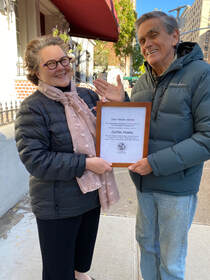
In conjunction with this presentation, the BNHG presented the annual "Jim Torain Award" to Caitlin Hawke
Since 2018, (with a hiatus in 2020 for the pandemic) the Bloomingdale Neighborhood History Group (BNHG) has honored the memory of their former member, Jim Torain, with the Torain Award. This year’s award is going to Caitlin Hawke for the impressive work she has done to help share and promote the history of our neighborhood.
About Jim Torain: Jim spent most of his life working tirelessly to preserve the legacy of the Old Community where he grew up. The Old Community is the name given to the African American neighborhood that flourished on West 98th and West 99th Street between Central Park West and Columbus Avenue--a neighborhood that was destroyed in 1955 as part of the city's urban renewal plan. Without Torain's work, the history of this vibrant neighborhood, once the home of so many talented and accomplished people, might have been lost to time.
About Caitlin Hawke: The members of the planning committee of the BNHG met Caitlin when putting together a series about medical institutions in the neighborhood. Caitlin, who had served for many years as Executive Director of the Pasteur Foundation, helped with background on the New York Pasteur Institute, the site of groundbreaking scientific research on rabies and tetanus vaccines, which once stood at 97th Street and Central Park West.
Over the past years, Caitlin has developed an extensive collection of historical photographs of our immediate neighborhood and researched the context of each, turning up many fascinating stories in the "Throwback Thursdays" posts on the blog she writes for the 102-103 Streets Block Association [https://www.w102-103blockassn.org/blog/category/throwback-thursday]. She has done impressive research on the history of the area and encouraged others to delve into it as well.
Over the years, as a volunteer with the 102-103rd Street Block Association as well as an early volunteer with Bloomingdale Aging in Place, she has encouraged others to dig out their historical photographs and to create oral history. In 2020, Caitlin presented the history of her own building, 855 West End Avenue, as part of BNHG’s ongoing series of public programs.
Caitlin’s fondness for the place she lives leads her to contribute her energies to creating the history of the neighborhood as she would like it to be, both as past co-coordinator of activities for Bloomingdale Aging in Place and through her current professional work as Associate Director of Programming at the Columbia Aging Center, a university-wide center housed at the Mailman School of Public Health.
Since 2018, (with a hiatus in 2020 for the pandemic) the Bloomingdale Neighborhood History Group (BNHG) has honored the memory of their former member, Jim Torain, with the Torain Award. This year’s award is going to Caitlin Hawke for the impressive work she has done to help share and promote the history of our neighborhood.
About Jim Torain: Jim spent most of his life working tirelessly to preserve the legacy of the Old Community where he grew up. The Old Community is the name given to the African American neighborhood that flourished on West 98th and West 99th Street between Central Park West and Columbus Avenue--a neighborhood that was destroyed in 1955 as part of the city's urban renewal plan. Without Torain's work, the history of this vibrant neighborhood, once the home of so many talented and accomplished people, might have been lost to time.
About Caitlin Hawke: The members of the planning committee of the BNHG met Caitlin when putting together a series about medical institutions in the neighborhood. Caitlin, who had served for many years as Executive Director of the Pasteur Foundation, helped with background on the New York Pasteur Institute, the site of groundbreaking scientific research on rabies and tetanus vaccines, which once stood at 97th Street and Central Park West.
Over the past years, Caitlin has developed an extensive collection of historical photographs of our immediate neighborhood and researched the context of each, turning up many fascinating stories in the "Throwback Thursdays" posts on the blog she writes for the 102-103 Streets Block Association [https://www.w102-103blockassn.org/blog/category/throwback-thursday]. She has done impressive research on the history of the area and encouraged others to delve into it as well.
Over the years, as a volunteer with the 102-103rd Street Block Association as well as an early volunteer with Bloomingdale Aging in Place, she has encouraged others to dig out their historical photographs and to create oral history. In 2020, Caitlin presented the history of her own building, 855 West End Avenue, as part of BNHG’s ongoing series of public programs.
Caitlin’s fondness for the place she lives leads her to contribute her energies to creating the history of the neighborhood as she would like it to be, both as past co-coordinator of activities for Bloomingdale Aging in Place and through her current professional work as Associate Director of Programming at the Columbia Aging Center, a university-wide center housed at the Mailman School of Public Health.
Zoom Presention, Monday, October 18, 2021
"Names of New York" with Joshua Jelly-Schapiro
"Names of New York" with Joshua Jelly-Schapiro
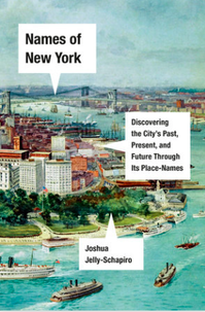
The Program: Writer, geographer and teacher Joshua Jelly-Schapiro presented an illustrated talk based on his latest book, Names of New York: Discovering the City's Past, Present, and Future through its Place-Names.
In this new book, Jelly-Schapiro takes a deep dive into the origins of the names of the city’s streets, parks, bridges, playgrounds and neighborhoods. His research is thorough and some of his discoveries are surprising. In his presentation he told the story behind the names of some Upper West Side locations that you may pass every day but haven't a clue as to how or why they got their names.
As Luc Sante, historian and author of Low Life: Lures and Snares of Old New York, writes, “Names of New York builds into a convincingly multifaceted portrait of the city—[it is] a book that is about much more than just names.”
In this new book, Jelly-Schapiro takes a deep dive into the origins of the names of the city’s streets, parks, bridges, playgrounds and neighborhoods. His research is thorough and some of his discoveries are surprising. In his presentation he told the story behind the names of some Upper West Side locations that you may pass every day but haven't a clue as to how or why they got their names.
As Luc Sante, historian and author of Low Life: Lures and Snares of Old New York, writes, “Names of New York builds into a convincingly multifaceted portrait of the city—[it is] a book that is about much more than just names.”
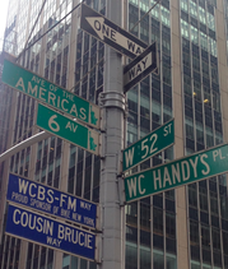
Jelly-Schapiro’s research traces the story of our city back to native Lenape, Dutch and British settlers and the waves of immigrants from everywhere in the world who have made NYC their home.
The book has been widely and well-reviewed. The Wall Street Journal called it “A vivid toponymic history” that is “intoxicating” and Publisher’s Weekly described it as a “fascinating smorgasbord."
Our Presenter: Joshua Jelly-Schapirpo’s books include Island People: The Caribbean and the World and, with Rebecca Solnit, Nonstop Metropolis: A New York City Atlas. He is a regular contributor to The New York Review of Books, and his work also appears in The New Yorker, The New York Times, and Harper’s Magazine, among many other publications. He is a scholar in residence at the Institute for Public Knowledge at New York University, where he also teaches.
The book has been widely and well-reviewed. The Wall Street Journal called it “A vivid toponymic history” that is “intoxicating” and Publisher’s Weekly described it as a “fascinating smorgasbord."
Our Presenter: Joshua Jelly-Schapirpo’s books include Island People: The Caribbean and the World and, with Rebecca Solnit, Nonstop Metropolis: A New York City Atlas. He is a regular contributor to The New York Review of Books, and his work also appears in The New Yorker, The New York Times, and Harper’s Magazine, among many other publications. He is a scholar in residence at the Institute for Public Knowledge at New York University, where he also teaches.
Zoom Presentation, Wednesday, September 22, 2021
"The 97th Street Greenmarket: Changes and Challenges" with Margaret Hoffman
"The 97th Street Greenmarket: Changes and Challenges" with Margaret Hoffman
The first day of autumn is when the early fall harvest is at its height, when pumpkins and squashes and apples begin to show up at the city’s greenmarkets. On our September 22 Zoom webinar, Margaret Hoffman, Greenmarket regional coordinator, told the story of the West 97th Street market, one of the most popular and longest- running greenmarkets in the city. She began with an overview of the farmers' market movement, how it began and how it keeps growing and adapting to changing times.
Assisted by Peter Arndsten, District Manager of the Columbus/Amsterdam BID, Hoffman talked about how the 97th Street greenmarket first came to the Bloomingdale neighborhood. She described its history, how its present site was chosen and the role it has played in both creating and developing a long-standing connection between upper west siders and regional farms. Some of the farmers who have stands at the market gave their insights on how the Greenmarket movement has promoted local agriculture and helped save small family farms, how it has encouraged immigrants to run farms, while at the same time providing healthful and delicious produce to city dwellers.
The 97th Street greenmarket is part of the GROW NYC network that was inspired by the first Earth Day back in the 1970s. These days the network also includes youth markets, fresh food box pick-ups, food scrap drop offs and textile recycling.
About the presenter:
Margaret Hoffman has been with Greenmarket/GROW NYC for 15th seasons and oversees 16 markets in northern Manhattan and the Bronx, markets that range in size from 3 or 4 to over 20 farm stands. As she describes them, the neighborhoods she serves are “as different as can be.“ She is a familiar presence at the 97th Street market and for many years has guided it through its many changes and challenges.
Assisted by Peter Arndsten, District Manager of the Columbus/Amsterdam BID, Hoffman talked about how the 97th Street greenmarket first came to the Bloomingdale neighborhood. She described its history, how its present site was chosen and the role it has played in both creating and developing a long-standing connection between upper west siders and regional farms. Some of the farmers who have stands at the market gave their insights on how the Greenmarket movement has promoted local agriculture and helped save small family farms, how it has encouraged immigrants to run farms, while at the same time providing healthful and delicious produce to city dwellers.
The 97th Street greenmarket is part of the GROW NYC network that was inspired by the first Earth Day back in the 1970s. These days the network also includes youth markets, fresh food box pick-ups, food scrap drop offs and textile recycling.
About the presenter:
Margaret Hoffman has been with Greenmarket/GROW NYC for 15th seasons and oversees 16 markets in northern Manhattan and the Bronx, markets that range in size from 3 or 4 to over 20 farm stands. As she describes them, the neighborhoods she serves are “as different as can be.“ She is a familiar presence at the 97th Street market and for many years has guided it through its many changes and challenges.
|
Memories of the 97th Street Greenmarket by June Russell , former market manager and farm inspector for GROW NYC:
|
| ||||||
Monday, June 21, 2021, Zoom Presentation
"Posh Portals of the Upper West Side" with Andrew Alpern
"Posh Portals of the Upper West Side" with Andrew Alpern
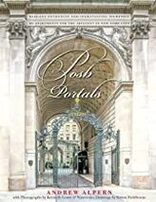
About the program: Andrew Alpern, a well-known and prolific author of books on NYC architectural history, put together a special presentation for the Bloomingdale Neighborhood History Group, focusing his unique historical lens on the “posh portals” of the Upper West Side.
According to Alpern “first impressions count” when it comes to the luxury buildings of the city, which is what inspired him to write Posh Portals. The New York Times called the book, the most recent of eleven he’s written on New York buildings, a “coffee-table bonbon and envy generator.”
Alpern believes that the entrance to a building conveys a lot of information about that building-- about its historical context, and about the sorts of people that its designer and builder were hoping to attract.
He explained that, to be successful, a building’s design needs to be distinctive; in context with the rest of the building; and look both welcoming and secure at the same time. An entrance-way needs to be more than just grand; it has to have genuine curb appeal, make passersby want to take a second, even a third look, and maybe even decide that they’d like to live there.
Posh Portals-- a lavish and beautifully constructed mix of text, photographs and original watercolor drawings-- surveys 168 buildings that the author considers the very best examples of his subject.
For this special presentation for the Bloomingdale Neighborhood History Group, he chose his favorite examples of the Upper West Side’s posh portals, and constructed a richly illustrated program that treated the audience to a one-of-a kind tour. (Take note that for the cover of his book, Alpern chose a photo of one of our neighborhood’s most easily recognizable posh portals.)
According to Alpern “first impressions count” when it comes to the luxury buildings of the city, which is what inspired him to write Posh Portals. The New York Times called the book, the most recent of eleven he’s written on New York buildings, a “coffee-table bonbon and envy generator.”
Alpern believes that the entrance to a building conveys a lot of information about that building-- about its historical context, and about the sorts of people that its designer and builder were hoping to attract.
He explained that, to be successful, a building’s design needs to be distinctive; in context with the rest of the building; and look both welcoming and secure at the same time. An entrance-way needs to be more than just grand; it has to have genuine curb appeal, make passersby want to take a second, even a third look, and maybe even decide that they’d like to live there.
Posh Portals-- a lavish and beautifully constructed mix of text, photographs and original watercolor drawings-- surveys 168 buildings that the author considers the very best examples of his subject.
For this special presentation for the Bloomingdale Neighborhood History Group, he chose his favorite examples of the Upper West Side’s posh portals, and constructed a richly illustrated program that treated the audience to a one-of-a kind tour. (Take note that for the cover of his book, Alpern chose a photo of one of our neighborhood’s most easily recognizable posh portals.)
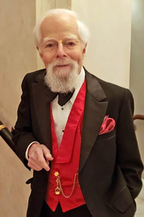
About the presenter: Andrew Alpern’s fascination with New York’s apartment houses began as a little boy when he would visit the apartments of his friends and would draw the layouts of the rooms to show his parents how those friends lived. This interest in architecture developed into a 30-year career as an architect. For a mid-life psychic jolt, he then went to law school and for 25 years he practiced law for a Wall Street partnership and then as General Counsel to an investment adviser firm until he retired two years ago at age 80.
During this entire time he has remained an architectural historian, turning that interest into eleven books and scores of published articles about historical architecture and particular buildings, along with dozens of book reviews and nearly 100 published Letters to the Editor. His expertise on New York’s apartment houses is legendary. His first book on the subject appeared in 1975 under the title of Apartments for the Affluent.
During this entire time he has remained an architectural historian, turning that interest into eleven books and scores of published articles about historical architecture and particular buildings, along with dozens of book reviews and nearly 100 published Letters to the Editor. His expertise on New York’s apartment houses is legendary. His first book on the subject appeared in 1975 under the title of Apartments for the Affluent.
Wednesday, May 26, 2021, Zoom Presentation:
"The Sounds Are the Story" with Alissa Cherry
"The Sounds Are the Story" with Alissa Cherry
Artist and investigator Alissa Cherry on the soundscapes of New York City, including our own neighborhood of Bloomingdale. Cherry spent four years working on "Sounds of the Outskirts," a series of investigative soundwalks around the perimeter of Manhattan. Her goal was to find the sonic shifts in the city, based on neighborhood, culture, population, location, etc. She focuses on understanding community changes through sound, or how you can hear a community via its music, language, and nature and industrial sounds.
During this interactive workshop, Cherry tasked us to think about the neighborhood through what we hear, rather than what we see. Cherry led a discussion about what certain things to pay attention to when outside on our daily walk,things like the languages spoken, the sounds of construction, and changes in sounds due to time of day or weather.
During this interactive workshop, Cherry tasked us to think about the neighborhood through what we hear, rather than what we see. Cherry led a discussion about what certain things to pay attention to when outside on our daily walk,things like the languages spoken, the sounds of construction, and changes in sounds due to time of day or weather.

Alissa Cherry hails from Montclair, New Jersey but has called the Upper West Side home for many years. She is a doctoral student at the University of Toronto, studying Social Justice Education and Workplace Learning and Social Change. Her background is in education and film.
Thursday, April 15th, 2021, Zoom Presentation
"Upper West Side en clave: Bailando en Bloomingdale"
Latin Music on the Upper West Side
with presenters Angel Roman, Felix Cortes and Dan McSweeney
"Upper West Side en clave: Bailando en Bloomingdale"
Latin Music on the Upper West Side
with presenters Angel Roman, Felix Cortes and Dan McSweeney
This webinar told the story of the major role that our neighborhood played in the world of popular Latin dance music over the past decades.
Introduced by Dan McSweeney, our presenters, Angel Roman and Felix Cortes, described the giants in the field who had connections to Bloomingdale: Mario Bauza (Machito Orchestra), Arsenio Rodriguez, Ismael Rivera and Angel Viloria. They shared video and audio recordings about dance clubs, jamming spots and home dance parties, the places that produced the soundtrack to the affirmation and resistance of the neighborhood’s working class.
Introduced by Dan McSweeney, our presenters, Angel Roman and Felix Cortes, described the giants in the field who had connections to Bloomingdale: Mario Bauza (Machito Orchestra), Arsenio Rodriguez, Ismael Rivera and Angel Viloria. They shared video and audio recordings about dance clubs, jamming spots and home dance parties, the places that produced the soundtrack to the affirmation and resistance of the neighborhood’s working class.
Tuesday, March 23, 2021, Zoom Presentation
"Bloomingdale in 1940: A Tour of Our Neighborhood Then and Now"
with presenters Julian Boilen, Gil Tauber and Jim Mackin
"Bloomingdale in 1940: A Tour of Our Neighborhood Then and Now"
with presenters Julian Boilen, Gil Tauber and Jim Mackin
Between 1939 and 1941, the Works Progress Administration (WPA) collaborated with the New York City Tax Department in an effort to photograph every building in the five boroughs. This ambitious project yielded a trove of thousands of photos of most of the city's buildings, which, in 2018, were digitized and tagged by the NYC Municipal Archives. In 2019, the web developer, Julian Boilen, built an online map ( https://1940s.nyc) that makes it possible for users to explore a city lost to time. Boilen’s project was both the inspiration and the basis for the evening’s program which was constructed much like a tour.
Julian explained how he came to build his map and Jim and Gil narrated the story of pieces of Bloomingdale that have been forgotten since the WPA photographers captured them on film.
About the presenters: Julian Boilen is a software engineer who loves both design and wandering around New York City. His online map https://1940s.nyc makes perfect use of both his skills and his interests. Every dot on the map is a photo; have fun and click on some. Julian will be joined by Gil Tauber and Jim Mackin, two local historians and members of the Bloomingdale Neighborhood History Group, who gave viewers an idea of how the Upper West Side evolved since the WPA photographers captured its buildings and shops on film those many decades ago.
Julian explained how he came to build his map and Jim and Gil narrated the story of pieces of Bloomingdale that have been forgotten since the WPA photographers captured them on film.
About the presenters: Julian Boilen is a software engineer who loves both design and wandering around New York City. His online map https://1940s.nyc makes perfect use of both his skills and his interests. Every dot on the map is a photo; have fun and click on some. Julian will be joined by Gil Tauber and Jim Mackin, two local historians and members of the Bloomingdale Neighborhood History Group, who gave viewers an idea of how the Upper West Side evolved since the WPA photographers captured its buildings and shops on film those many decades ago.
Tuesday, February 16, 2021 Zoom Presentation
"Two First-Time Authors, Two Local Histories"
with first-time authors Jim Mackin and Matthew Spady moderated by Fred Nachbaur, director of Fordham University Press
"Two First-Time Authors, Two Local Histories"
with first-time authors Jim Mackin and Matthew Spady moderated by Fred Nachbaur, director of Fordham University Press
Jim Mackin and Matthew Spady described first- time authorship, their shared interest in local history, how they conceptualized their books and how they found a publisher. They shared their research methods, their writing regimen, the how-tos of fact-checking, editing and finally, promoting their books.
About the books:
Mackin’s book, Notable New Yorkers of Manhattan’s Upper West Side, is a compilation of stories of nearly 600 former residents who once called the Upper West Side home. While his focus is primarily on the 600, Mackin artfully slips in some fascinating facts and colorful stories about the neighborhood itself.
Spady’s book, The Neighborhood Manhattan Forgot: Audubon Park and the Families Who Shaped It, traces the area’s complex history of an area of northern Manhattan that began as undeveloped woodlands and has evolved into a large, multi-ethnic, big-city neighborhood. The story he tells is framed by the lives of two families--the Grinnells and the Audubons. (Yes, that Audubon!)
Both books are part of the Fordham University Press’s Empire State Editions, an imprint well-known for its local histories. (www.fordhampress.com/)
About the panelists:
Jim Mackin is a member of the Bloomingdale Neighborhood History Group, a local historian and the force behind Weekday Walks https://www.weekdaywalks.com/.
Mackin's past programs for the BNHG have been enormously popular and his guided tours of the West Side are a must for anyone who lives in the neighborhood or has any interest in the history of the city.
Matthew Spady, a local historian, has spent years delving into the history of Audubon Park, focusing on two 19th century men and their families who were central to the neighborhood’s creation, John James Audubon and George Bird Grinnell.
Spady is the creator of the virtual walking tour AudubonParkNY.com and curator for www.AudubonParkPerspectives.org , a news site that reflects on the constant intersection of past and present in his vibrant and historic neighborhood.
Fred Nachbaur has close to 30 years of experience in book publishing. He became the director of Fordham University Press in 2009.
About the books:
Mackin’s book, Notable New Yorkers of Manhattan’s Upper West Side, is a compilation of stories of nearly 600 former residents who once called the Upper West Side home. While his focus is primarily on the 600, Mackin artfully slips in some fascinating facts and colorful stories about the neighborhood itself.
Spady’s book, The Neighborhood Manhattan Forgot: Audubon Park and the Families Who Shaped It, traces the area’s complex history of an area of northern Manhattan that began as undeveloped woodlands and has evolved into a large, multi-ethnic, big-city neighborhood. The story he tells is framed by the lives of two families--the Grinnells and the Audubons. (Yes, that Audubon!)
Both books are part of the Fordham University Press’s Empire State Editions, an imprint well-known for its local histories. (www.fordhampress.com/)
About the panelists:
Jim Mackin is a member of the Bloomingdale Neighborhood History Group, a local historian and the force behind Weekday Walks https://www.weekdaywalks.com/.
Mackin's past programs for the BNHG have been enormously popular and his guided tours of the West Side are a must for anyone who lives in the neighborhood or has any interest in the history of the city.
Matthew Spady, a local historian, has spent years delving into the history of Audubon Park, focusing on two 19th century men and their families who were central to the neighborhood’s creation, John James Audubon and George Bird Grinnell.
Spady is the creator of the virtual walking tour AudubonParkNY.com and curator for www.AudubonParkPerspectives.org , a news site that reflects on the constant intersection of past and present in his vibrant and historic neighborhood.
Fred Nachbaur has close to 30 years of experience in book publishing. He became the director of Fordham University Press in 2009.
Thursday, January 21, 2021 Zoom Presentation
"Trinity Lutheran Church: Creating Sanctuary and Social Change"
with Heidi Neumark, pastor of Trinity Lutheran Church on 100th Street and author of Sanctuary
"Trinity Lutheran Church: Creating Sanctuary and Social Change"
with Heidi Neumark, pastor of Trinity Lutheran Church on 100th Street and author of Sanctuary
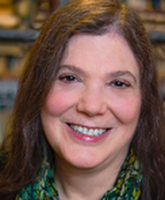
Heidi Neumark, pastor of Trinity Lutheran Church on 100th Street, discussed the multiple ways the church and its members have grappled with the issues of our times, from AIDS to gentrification, to a changing population and neighborhood, to providing sanctuary for LBTGQ youth. Heidi's just-published book Sanctuary tells these and many other stories.
Heidi Neumark's most recent book, Sanctuary: Being Christian in the Wake of Trump, is available through https://bookshop.org/books/sanctuary-being-christian-in-the-wake-of -trump/9780802878397 as well as Barnes & Noble or Amazon.
Read a description of Rev. Neumark's latest book Sanctuary at the BNHG Bookshelf
Heidi Neumark's most recent book, Sanctuary: Being Christian in the Wake of Trump, is available through https://bookshop.org/books/sanctuary-being-christian-in-the-wake-of -trump/9780802878397 as well as Barnes & Noble or Amazon.
Read a description of Rev. Neumark's latest book Sanctuary at the BNHG Bookshelf
Past Events of 2020
Monday, November 30, 2020 Zoom Presentation
Jim Mackin, local historian, with highlights from his recently published book
Notable New Yorkers on Manhattan’s Upper West Side: Bloomingdale - Morningside Heights.
Jim Mackin, local historian, with highlights from his recently published book
Notable New Yorkers on Manhattan’s Upper West Side: Bloomingdale - Morningside Heights.
Author Jim Mackin talked about his new book, some of the people he’s written about and some of the curiosities about the neighborhood that he uncovered during the course of his research.
About the book: What do Humphrey Bogart and Patty Hill (co-author of “Happy Birthday,” the most popular song of all time) have in common? Both of them once lived in the neighborhood of Morningside Heights and Bloomingdale, a strip of land that runs from the 90s to 125th Street, between the Hudson River and Central Park. Spanning hundreds of years, Notable New Yorkers of Manhattan’s Upper West Side is a compilation of stories of nearly 600 former residents who once called Manhattan’s Upper West Side home.
Over the years, the Upper West Side has gone from farmland and summer homes, to Revolutionary War battleground, to a working-class community with enclaves of the wealthy, to the diverse community it is today. Profiling a rare selection of wildly diverse people who shaped the character of the area, Mackin introduces readers to its fascinating residents: some famous, such as George and Ira Gershwin and Thurgood Marshall, and some forgotten, such as Harriet Brooks, Augustus Meyers, and Elinor Smith. Brief biographies reveal intriguing facts about this group, which include scientists, explorers, historians, journalists, artists, entertainers, aviators, public officials, lawyers, judges, and more.
While the focus is on people, the book includes an eclectic collection of interesting facts and colorful stories about the neighborhood, including the 9th Avenue El, Little Coney Island, and, notoriously, one of the most dangerous streets in the city, as well as songs and movies that were written and shot in the neighborhood.
Michael Miscione, Manhattan Borough Historian from 2006-2019, read the book and had this to say: Mackin’s book “is an exhaustive and ofttimes surprising Who’s Who of Upper West Siders who have shaped the worlds of art, culture, politics, and science. After reading his book I thought, ‘Harlem and Greenwich Village boosters take note! The Upper West Side deserves a seat at the table.’”
The book is available at
https://www.fordhampress.com/9780823289295/notable-new-yorkers-of-manhattans-upper-west-side/

About Jim Mackin: Mackin is a member of the Bloomingdale Neighborhood History Group, a local historian and the force behind Weekday Walks https://www.weekdaywalks.com/.
Wednesday, November 18,2020 Zoom Presentation
"Riverside South and Riverside Center: A 40 Year Upper West Side Development Story"
Presenter: Ethel Sheffer
Sponsored by the Bloomingdale Neighborhood History Group, Community Board 7 and Manhattan Borough President Gale Brewer
About the program: The development of the land along the Hudson River, from West 59th Street to West 72nd Street, land once known as Penn Yards, is a four-decades- long story with plot twists and turns and a cast of characters worthy of a television mini-series. The players included developers, celebrities, community leaders, elected officials and neighborhood residents who battled and compromised and eventually came to agreement on final proposals.
Sheffer who was involved in the evolution of the development from its beginning in 1980 to its final approvals in 2010, and has continued to participate in CB7 on controversies and issues concerning individual buildings and major legal issues, gave the audience an historical overview, illustrated by images that she has collected over the years.
In addition to the history of that particular slice of the Upper West Side, she addressed some of the most important questions that face New Yorkers about the future of the city: questions about who should be doing the planning, what role the private and public sectors should play in that planning and how the community should be involved so that its needs and wishes are successfully incorporated into any final plan.
Sheffer emphasized lessons learned from Riverside South, helped the audience understand what good planning is and how it will influence, for better or worse, the way the city grows in post-pandemic times.
Sheffer who was involved in the evolution of the development from its beginning in 1980 to its final approvals in 2010, and has continued to participate in CB7 on controversies and issues concerning individual buildings and major legal issues, gave the audience an historical overview, illustrated by images that she has collected over the years.
In addition to the history of that particular slice of the Upper West Side, she addressed some of the most important questions that face New Yorkers about the future of the city: questions about who should be doing the planning, what role the private and public sectors should play in that planning and how the community should be involved so that its needs and wishes are successfully incorporated into any final plan.
Sheffer emphasized lessons learned from Riverside South, helped the audience understand what good planning is and how it will influence, for better or worse, the way the city grows in post-pandemic times.
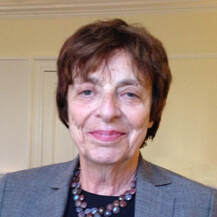
About the presenter:
Ethel Sheffer is a long-time member of Community Board 7 where she has served as Chair of the Board and as chairperson of major committees and task forces concerned with the development history of the rail yards.
She has served as a Commissioner on the NYC Public Design Commission, as President of the American Planning Association NY Metro Chapter, and has been an Adjunct Professor at Columbia University’s Graduate School of Architecture, Planning and Preservation.
Ethel Sheffer is a long-time member of Community Board 7 where she has served as Chair of the Board and as chairperson of major committees and task forces concerned with the development history of the rail yards.
She has served as a Commissioner on the NYC Public Design Commission, as President of the American Planning Association NY Metro Chapter, and has been an Adjunct Professor at Columbia University’s Graduate School of Architecture, Planning and Preservation.
Zoom Presentation of "Hidden History of The Upper West Side: Seneca Village" on
October 27, 2020 with presenter Philip Andrew Stern
October 27, 2020 with presenter Philip Andrew Stern
Hidden History of The Upper West Side: Seneca Village
Presenter: Philip Andrew Stein
About the program: The evening’s story begins back in the 1820s when much of the upper west side was open countryside with very few--probably no more than 1600--people living here. About 200 of these people were free Blacks who bought up affordable plots in what is now Central Park. They built themselves homes, churches and a school in the area that became known as Seneca Village.
When Irish and German immigrants moved in, the village became a rare example of an integrated neighborhood. However, on July 21, 1853, everything changed for the residents of the Village. That’s when the city claimed the land and all structures on it, razed it all and started start work on the park.
The program will be an introduction to the history of this significant 19th century community, a history which, for more than a hundred years, remained largely unknown to many New Yorkers. The presenter, Philip Andrew Stein, will share information that has been recently uncovered about the Village and reveal some resources that have been newly developed.
As Stein explains, “If you have been on a tour of Seneca Village before, this will be an update for you; if you haven’t, this will be a useful introduction to the subject.”
About the presenter: Philip Andrew Stein is a 45 year resident of Manhattan and an 18 year resident of the Upper West Side. Retired professionally, he has been performing volunteer work for several cultural organizations including the New-York Historical Society as an explainer and for the Central Park Conservancy as a tour guide. His tours for the Conservancy have focused on pre-park history, park history, statues and monuments, landscape and park design. For most of the 12 years that he has been involved with the Conservancy, he has guided tours of the Seneca Village site.
Presenter: Philip Andrew Stein
About the program: The evening’s story begins back in the 1820s when much of the upper west side was open countryside with very few--probably no more than 1600--people living here. About 200 of these people were free Blacks who bought up affordable plots in what is now Central Park. They built themselves homes, churches and a school in the area that became known as Seneca Village.
When Irish and German immigrants moved in, the village became a rare example of an integrated neighborhood. However, on July 21, 1853, everything changed for the residents of the Village. That’s when the city claimed the land and all structures on it, razed it all and started start work on the park.
The program will be an introduction to the history of this significant 19th century community, a history which, for more than a hundred years, remained largely unknown to many New Yorkers. The presenter, Philip Andrew Stein, will share information that has been recently uncovered about the Village and reveal some resources that have been newly developed.
As Stein explains, “If you have been on a tour of Seneca Village before, this will be an update for you; if you haven’t, this will be a useful introduction to the subject.”
About the presenter: Philip Andrew Stein is a 45 year resident of Manhattan and an 18 year resident of the Upper West Side. Retired professionally, he has been performing volunteer work for several cultural organizations including the New-York Historical Society as an explainer and for the Central Park Conservancy as a tour guide. His tours for the Conservancy have focused on pre-park history, park history, statues and monuments, landscape and park design. For most of the 12 years that he has been involved with the Conservancy, he has guided tours of the Seneca Village site.
Zoom Presentation of "Bloomingdale Goes to the Movies" on September 22, 2020 with presenters Jim Mackin and Gil Tauber
About the program:
Remember when you used to go to the movies? The real movies? With seats and popcorn and other people? The hour-long program took viewers back to the nineteenth century when there were at least 17 theaters in our neighborhood.
Most of these 17 were built in the space of just a few years, starting in 1911, at a time when all of America was engaged in a full- on love affair with Hollywood. At one time, there were three movie theaters on West 110th street alone and, contrary to what you may have assumed, not all were on Broadway. Only one of these theaters still remains and only a few of the original structures still stand and those that do remain have been so completely transformed that it is hard to imagine that they were once film palaces.
The program’s three presenters-- Jim Mackin, Gil Tauber, and Dan Armstrong, all members of the BNHG planning committee--told the story of how and where Bloomingdale’s theaters lived and how they died. They described Bloomingdale’s “Little Times Square” with its thousands of seats for movie-goers (some even on the roofs of the theaters) and show you vestigial remnants of old theaters in buildings that you probably walk by every day.
About the presenters:
Jim Mackin’s book Notable New Yorkers of Manhattan’s Upper West Side: Bloomingdale-Morningside Heights (Fordham University Press) will be available November 3rd but can be pre-ordered at Bookloft on West 112th Street or Amazon or Barnes and Noble. He is also the force behind Weekday Walks (www.weekdaywalks.com)
Gil Tauber has created the Bloomingdale Building Database which is accessible on the BNHG website (www.upperwestsidehistory.org). His research into the history of NY street names can be found at http://www.oldstreets.com/.
Dan Armstrong has lived in Bloomingdale since graduating from Columbia University in 1982 and was a frequent visitor, with his son, to the Olympia theater. He was an auxiliary cop in the 24th and Central Park precincts and was briefly Barack Obama’s editor when the former president lived on West 109th Street.
Remember when you used to go to the movies? The real movies? With seats and popcorn and other people? The hour-long program took viewers back to the nineteenth century when there were at least 17 theaters in our neighborhood.
Most of these 17 were built in the space of just a few years, starting in 1911, at a time when all of America was engaged in a full- on love affair with Hollywood. At one time, there were three movie theaters on West 110th street alone and, contrary to what you may have assumed, not all were on Broadway. Only one of these theaters still remains and only a few of the original structures still stand and those that do remain have been so completely transformed that it is hard to imagine that they were once film palaces.
The program’s three presenters-- Jim Mackin, Gil Tauber, and Dan Armstrong, all members of the BNHG planning committee--told the story of how and where Bloomingdale’s theaters lived and how they died. They described Bloomingdale’s “Little Times Square” with its thousands of seats for movie-goers (some even on the roofs of the theaters) and show you vestigial remnants of old theaters in buildings that you probably walk by every day.
About the presenters:
Jim Mackin’s book Notable New Yorkers of Manhattan’s Upper West Side: Bloomingdale-Morningside Heights (Fordham University Press) will be available November 3rd but can be pre-ordered at Bookloft on West 112th Street or Amazon or Barnes and Noble. He is also the force behind Weekday Walks (www.weekdaywalks.com)
Gil Tauber has created the Bloomingdale Building Database which is accessible on the BNHG website (www.upperwestsidehistory.org). His research into the history of NY street names can be found at http://www.oldstreets.com/.
Dan Armstrong has lived in Bloomingdale since graduating from Columbia University in 1982 and was a frequent visitor, with his son, to the Olympia theater. He was an auxiliary cop in the 24th and Central Park precincts and was briefly Barack Obama’s editor when the former president lived on West 109th Street.
Tuesday, February 25, 2020, 6:30pm at the Ballroom of the Hostel International
"Upper West Side Catholics: the History of Ascension Church on West 107th Street"
presented by Monsignor Thomas J. Shelley
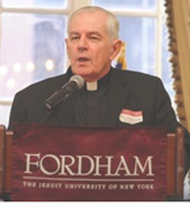
Monsignor Shelley, author of the recently published book Upper West Side Catholics: Liberal Catholicism in a Conservative Archdiocese and professor emeritus of Fordham, told the story of this well-known Upper West Side church. He described Ascension as a microcosm of the history of the Catholic Church in the city, a flourishing multi-ethnic bilingual parish and vital part of the Bloomingdale neighborhood. The church, which began as a small German parish in 1858, developed into a large Irish parish, but declined precipitously from the 1960s to the 1980s. An influx of Puerto Rican and Dominican Catholics rescued Ascension from near-extinction, creating a showcase for successful urban ethnic Catholicism.
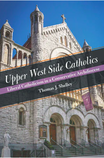
Upper West Side Catholics includes more information on the Lion Brewery than any other book about the Upper West Side. The Brewery stood just a few blocks from the church from the mid 1800s to 1944, spanning a huge piece of land that stretched from W107th to W109th Streets and Columbus Avenue to CPW. Monsignor Shelley has written several books including The Bicentennial History of the Archdiocese of New York and Fordham: A History of the Jesuit University of New York: 1841-2003.
Thursday, February 13, 2020, 6:30pm at the Ballroom of the Hostel International
"Andrew Williams of Seneca Village: A Family Visionary and his Descendants"
"Andrew Williams of Seneca Village: A Family Visionary and his Descendants"

Cal Jones, Manhattan Borough Historian Emeritus, traced the history of the Andrew Williams family from the mid 1800s to the present. Williams, a bootblack and cartman, bought land in Seneca Village, a community composed primarily of African Americans that once thrived on land that is now part of Central Park, from West 83rd Street to West 89th Street. He built a house on three plots that he had purchased for $120, moved in with his wife Elizabeth, and eventually raised his family there.
The Williams family lived in Seneca Village from 1825 to 1857 when life there came to an abrupt end. The entire village was acquired by the city via eminent domain and all of its homes, two schools and three churches were razed to make room for the new park. After two years of research, Jones reconstructed the trajectory of the Williams family, all the way to the present day, illustrating his presentation with photos and biographical notes of five generations.
The Williams family lived in Seneca Village from 1825 to 1857 when life there came to an abrupt end. The entire village was acquired by the city via eminent domain and all of its homes, two schools and three churches were razed to make room for the new park. After two years of research, Jones reconstructed the trajectory of the Williams family, all the way to the present day, illustrating his presentation with photos and biographical notes of five generations.
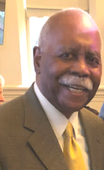
Cal Jones served as Manhattan Borough Historian for three Borough Presidents, beginning in 1997. He has been a contributor to The Encyclopedia of New York City and the author of the Manhattan African-American History and Culture Guide, published by the Manhattan Borough President and the Museum of the City of New York. He volunteers at the Museum of the City of New York, teaching history to school children. Among his many other affiliations, he is a member of the Institute for the Exploration of Seneca Village History.
In recognition of his ongoing and energetic support of community historians, Jones was awarded the Jim Torain Award from the Bloomingdale Neighborhood History Group in 2019.
In recognition of his ongoing and energetic support of community historians, Jones was awarded the Jim Torain Award from the Bloomingdale Neighborhood History Group in 2019.
Tuesday, January 14, 2020 , 630pm at the Ballroom of the Hostel International
"The Marvelous Maggie Mitchell and the St. Andoche, 855 West End Avenue"
"The Marvelous Maggie Mitchell and the St. Andoche, 855 West End Avenue"
|
Longtime Bloomingdale resident and Block Association blogger Caitlin Hawke told the story of the St. Andoche, a building constructed for beloved Civil War actor Maggie Mitchell who lived there for two decades until her death at the age of 81 in 1918. In the mid 1800s, Mitchell’s fame was second only to actor Edwin Booth, brother of John Wilkes Booth. Her obituary in the New York Times described her as “known to playgoers of another generation as one of the most famous of American actresses”.
|
Although Mitchell’s story has been largely forgotten, the eight-story colonial revival St. Andoche still stands proudly on the southwest corner of West 102nd Street. Hawke’s illustrated talk presented the story of both the actress and “her” building, including the details of the actor's extraordinary career and how the building got its unusual name.
Past Events of 2019
Wednesday, December 4, 2019, 630pm at the Ballroom of the Hostel International
Wednesday, December 4, 2019, 630pm at the Ballroom of the Hostel International
"A Novel Synthesis of Planning, Environmental and Urban History"
Presented by Kara Murphy Schlichting, author of the recently published New York Recentered: Building the Metropolis from the Shore.
Presented by Kara Murphy Schlichting, author of the recently published New York Recentered: Building the Metropolis from the Shore.
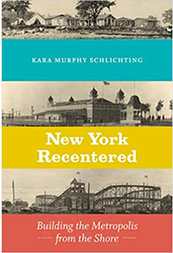
In New York Recentered: Building the Metropolis from the Shore Schlichting examines the city’s geographic edges—the coastlines and waterways—and the small-time unelected locals and residents who quietly, but indelibly, shaped the modern city alongside power brokers like Robert Moses. It challenges the idea that urbanization is always a linear progression and that growth is always directed by central planners and government officials. Ordinary citizens (like joggers in waterfront parks!) also played a role. Her book is a synthesis of planning history, environmental history and urban history that recasts the story of our city.
Kara Murphy Schlichting is an Assistant Professor at Queens College CUNY with a specialty in urban and environmental history, 19th and 20th century New York City, its parks, suburbs, and beaches.
Kara Murphy Schlichting is an Assistant Professor at Queens College CUNY with a specialty in urban and environmental history, 19th and 20th century New York City, its parks, suburbs, and beaches.
Tuesday, November 5 ,2019, 630pm, Ballroom of the Hostel International-NYC
“The Central Park - A Northern View of New York’s Greatest Treasure”
A presentation by Cynthia S. Brenwall, author of the recently published book, The Central Park: Original Designs for New York's Greatest Treasure.
“The Central Park - A Northern View of New York’s Greatest Treasure”
A presentation by Cynthia S. Brenwall, author of the recently published book, The Central Park: Original Designs for New York's Greatest Treasure.
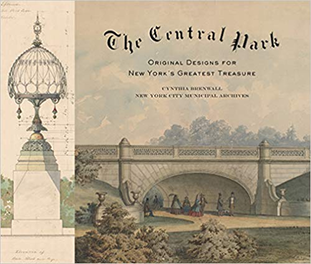
In The Central Park Cynthia Brenwall draws on the unparalleled collection of original designs for Central Park in the New York City Municipal Archives to tell the story of the creation of New York’s great public park from conception to completion.
For the November 5th program, Brenwall pulled from this treasure trove of visual materials, illustrating her talk with meticulously detailed maps and plans of buildings, both built and unbuilt. She included the elegant designs for the many fixtures that were required in a world of gaslight and horses. The talk focused on the rich history of the northern end of the park, while highlighting what brilliant urban planning can do for a great city.
For the November 5th program, Brenwall pulled from this treasure trove of visual materials, illustrating her talk with meticulously detailed maps and plans of buildings, both built and unbuilt. She included the elegant designs for the many fixtures that were required in a world of gaslight and horses. The talk focused on the rich history of the northern end of the park, while highlighting what brilliant urban planning can do for a great city.
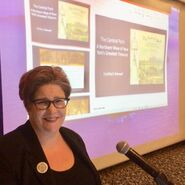
Cynthia S. Brenwall, a conservator and art historian, has worked for the New York City Municipal Archives since 2012. During her tenure she has cared for some of New York’s most important historical documents including the conservation and documentation of the Central Park Collection.
Two of the many images in The Central Park: Original Designs for New York's Greatest Treasure:
Wednesday, October 16 ,2019 at 630pm,Ballroom of the Hostel International-NYC
How a Community Blooms: An Oral History of the BAiP
How a Community Blooms: An Oral History of the BAiP
Bloomingdale Aging in Place, known fondly as BAiP, is a thriving local community of upper west side neighbors who share information, social activities and help each other in imaginative ways (walking, knitting, wine tasting, playing ping pong and much more) as they age. Its genesis ten years ago is preserved in a recent oral history project with some of the founders, taken by other BAiP members.
This program, sponsored by the Bloomingdale Neighborhood History Group, presented
This program, sponsored by the Bloomingdale Neighborhood History Group, presented
- The words of several of BAiP's founders, how the organization came into being, how it has grown, and how it functions today as a model for similar future efforts.
- Some of the neighbors who played a role in the founding of BAiP.
- How oral history differs from, and adds to, other types of historical research.
Tuesday, September 24 ,2019 at 630pm,Ballroom of the Hostel International-NYC
"Tin Pan Alley Uptown and Down: The composers, lyricists and song publishers who lived in the Bloomingdale neighborhood and worked in Tin Pan Alley"
"Tin Pan Alley Uptown and Down: The composers, lyricists and song publishers who lived in the Bloomingdale neighborhood and worked in Tin Pan Alley"
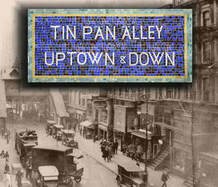
Many of the composers, lyricists, and publishers of the hit songs of the 20th century commuted from the Bloomingdale neighborhood on the Upper West Side to Tin Pan Alley, just north of Madison Square. To honor these talented former residents of our neighborhood, the Bloomingdale Neighborhood History Group organized a program that combined a multimedia presentation, a history talk, and an update on efforts to landmark the Tin Pan Alley area, accompanied by a live performance of music that originated from that storied slice of Manhattan.
The multimedia presentation was produced by Lesley Doyel, former president of Save Chelsea along with media specialist Nick Fritsch; the talk was presented by local historian Jim Mackin; and an update of the landmarking efforts was given by George Calderaro, head of the Save the Tin Pan Alley Initiative Project of the 29th Street Neighborhood Association.
In his talk Jim Mackin included the composers pictured below and the addresses where they lived in the Bloomingdale neighborhood:
In his talk Jim Mackin included the composers pictured below and the addresses where they lived in the Bloomingdale neighborhood:
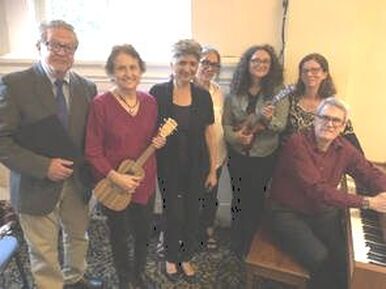
As a special treat, some of the best music from Tin Pan Alley was performed by well-known bass Peter Becker, pianist Peter Homans, and the musical group The Accord-O-Leles. (The musical portion of the program was organized by What a Neighborhood, a not for profit that promotes the work of local performers and composers.)
(Pictured left to right are Peter Becker (bass); Katie Cangelosi, Patricia Aranibar, Elizabeth Inserra, Margaret Cuonzo, and Vita Wallace (the Accord-O-Leles); Peter Homans at the piano.)
(Pictured left to right are Peter Becker (bass); Katie Cangelosi, Patricia Aranibar, Elizabeth Inserra, Margaret Cuonzo, and Vita Wallace (the Accord-O-Leles); Peter Homans at the piano.)
Watch Video of this Presentation:
Monday, June 3,2019 at 630pm,Ballroom of the Hostel International-NYC
Fran Leadon spoke about his book Broadway: A History of New York in 13 Miles.
Fran Leadon spoke about his book Broadway: A History of New York in 13 Miles.
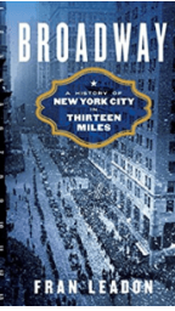
In a New York Times review, Clyde Haberman described Leadon's book as "a tale of a whirl of characters: architects and landlords, capitalists and unionists, reformers and traditionalists, visionaries and charlatans. It is a whirl, too, of events like ticker-tape parades, civic battles, financial booms and inevitable busts. Enlivening the stories are cameo appearances by the rich and famous.."
In Broadway: A History of New York City in Thirteen Miles, architect Fran Leadon takes on a monumental task: to uncover the news events, people, businesses, and buildings–mile by mile–that have contributed to New York’s best-known street. Beginning as a muddy path that cut through the Dutch colony of New Amsterdam and dissolved into farmland, Broadway has evolved over 200 years to host a chaotic mix of traffic, hotels, stores, theaters, churches, and people. In its first mile, you can see 400 years of history, from the Civil War to the emergence of skyscrapers. Moving uptown, Broadway takes us to the city’s cherished public spaces–Union Square, Herald Square and Times Square–as well as the Theater District and Great White Way. The street continues to upper Manhattan, where the story of urban renewal plays out, then cuts through the Bronx and winds all the way to Albany.
In his book, Leadon focuses on Manhattan’s relationship with Broadway, making the argument that you can tell the story of NYC–and even the country–through these 13 miles. “Broadway was never just a thoroughfare; it has always been, first and foremost, a place,” he writes. Leadon talks about understanding Broadway, a street he often experienced in fragments, as a single 13-mile thoroughfare that serves as the lifeblood of New York. He also discusses how years of research and discovery made it to the pages, surprising histories that emerged along the way, and why he’s still writing the history of Broadway in his head.
In Broadway: A History of New York City in Thirteen Miles, architect Fran Leadon takes on a monumental task: to uncover the news events, people, businesses, and buildings–mile by mile–that have contributed to New York’s best-known street. Beginning as a muddy path that cut through the Dutch colony of New Amsterdam and dissolved into farmland, Broadway has evolved over 200 years to host a chaotic mix of traffic, hotels, stores, theaters, churches, and people. In its first mile, you can see 400 years of history, from the Civil War to the emergence of skyscrapers. Moving uptown, Broadway takes us to the city’s cherished public spaces–Union Square, Herald Square and Times Square–as well as the Theater District and Great White Way. The street continues to upper Manhattan, where the story of urban renewal plays out, then cuts through the Bronx and winds all the way to Albany.
In his book, Leadon focuses on Manhattan’s relationship with Broadway, making the argument that you can tell the story of NYC–and even the country–through these 13 miles. “Broadway was never just a thoroughfare; it has always been, first and foremost, a place,” he writes. Leadon talks about understanding Broadway, a street he often experienced in fragments, as a single 13-mile thoroughfare that serves as the lifeblood of New York. He also discusses how years of research and discovery made it to the pages, surprising histories that emerged along the way, and why he’s still writing the history of Broadway in his head.
Monday, May 20, 2019 at 630pm,Ballroom of the Hostel International-NYC
"Legal Landmarks on the Upper West Side"
"Legal Landmarks on the Upper West Side"
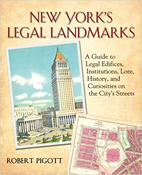
Robert Piggott, author of New York’s Legal Landmarks, gave an illustrated talk highlighting the law-related buildings, personalities and history of Manhattan and the outer boroughs with a special section on the Upper West Side.
Thursday, May 9, 2019 at 630pm, Ballroom of the Hostelling International NY
"The Hudson River Waterfront on the Upper West Side: 400 Years of Conflict & Change"
"The Hudson River Waterfront on the Upper West Side: 400 Years of Conflict & Change"
Dr. Kurt Schlichting, Professor of Sociology and author of Waterfront Manhattan: from Henry Hudson to the High Line, told the story of the Upper West Side's waterfront, the forces that have shaped both its look and its function from the 1600s up to today.
Professor Schlichting's book was unavailable for sale at the presentation but can be purchased from his publisher at https://jhupbooks.press.jhu.edu/title/waterfront-manhattan
Professor Schlichting's book was unavailable for sale at the presentation but can be purchased from his publisher at https://jhupbooks.press.jhu.edu/title/waterfront-manhattan
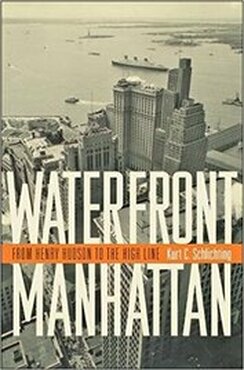
The story of New York City and the Port of New York can be told through the use of the shoreline. When first settled, the city’s wharfs and piers lined the East River from Corlear’s Hook to the Battery. As the port prospered, the need for additional piers led to development of the of the Hudson River waterfront. It seemed inevitable that the shoreline along the Upper West Side would be developed for shipping and maritime commerce.
Following the waterfront development, Manhattan’s population exploded. First street car lines, elevated railroads and then the subway led to a building boom in the Upper West Sides streets between Central Park and the Hudson River.
A protracted conflict ensued over the development of the Upper West Side. The New York Central Railroad had acquired the rights to use the shoreline for its freight and passenger trains and the adamantly refused to remove its tracks. Riverside Park remained cut off from waterfront access for decades. Wealthy New Yorkers’ built luxury homes with Hudson River views while immigrants and their descendents sought decent housing.
Following the waterfront development, Manhattan’s population exploded. First street car lines, elevated railroads and then the subway led to a building boom in the Upper West Sides streets between Central Park and the Hudson River.
A protracted conflict ensued over the development of the Upper West Side. The New York Central Railroad had acquired the rights to use the shoreline for its freight and passenger trains and the adamantly refused to remove its tracks. Riverside Park remained cut off from waterfront access for decades. Wealthy New Yorkers’ built luxury homes with Hudson River views while immigrants and their descendents sought decent housing.
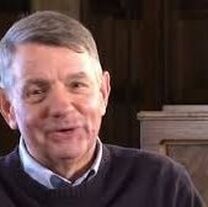
Dr. Kurt Schlichting, Fairfield University, is the E. Gerald Corrigan ’63 Chair in Humanities and Social Sciences Emeritus and a Professor of Sociology. At Fairfield he has served as Dean and Associate Dean of the College of Arts & Sciences.
His most recent book for Johns Hopkins University Press, Waterfront Manhattan: from Henry Hudson to the High Line, was published in May of 2018. His previous book for Johns Hopkins, Grand Central Terminal: Railroads, Architecture and Engineering in New York won the 2002 Association of American Publishers award as the Best Professional/ Scholarly Book in Architecture & Urbanism. The book was the basis for the 2008 PBS - The American Experience – "Grand Central", an award winning documentary.
Jameson W. Doig, author of Empire on the Hudson, praised Waterfront Manhattan: “(Schlichting) succeeds admirably in describing the evolution of Manhattan’s waterfront through the past several centuries--so far as I know there is no published work of such scope and richness.”
His most recent book for Johns Hopkins University Press, Waterfront Manhattan: from Henry Hudson to the High Line, was published in May of 2018. His previous book for Johns Hopkins, Grand Central Terminal: Railroads, Architecture and Engineering in New York won the 2002 Association of American Publishers award as the Best Professional/ Scholarly Book in Architecture & Urbanism. The book was the basis for the 2008 PBS - The American Experience – "Grand Central", an award winning documentary.
Jameson W. Doig, author of Empire on the Hudson, praised Waterfront Manhattan: “(Schlichting) succeeds admirably in describing the evolution of Manhattan’s waterfront through the past several centuries--so far as I know there is no published work of such scope and richness.”
Thursday, April 18, 2019 at 630pm, Ballroom of the Hostelling International NY
"Neighborhood Stores, Past and Future"
"Neighborhood Stores, Past and Future"
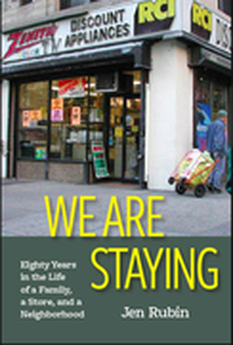
Jen Rubin, author of We Are Staying: Eighty Years in the Life of a Family, a Store, and a Neighborhood, told the story of Radio Clinic, the store opened in 1934 by her immigrant grandfather (who began by repairing radios in full view of passersby) and passed on to her father who ran it until its closing in 2014. Over its 80 years as an UWS fixture, the business evolved from a repair shop to an appliance store, selling “radios, televisions, big and small appliances, electronics, and air conditioners-- lots and lots of air conditioners.”
We Are Staying tells not only the story of a business, a family and a neighborhood, but also the changes in the nature of businesses in New York and the impact those changes have on surrounding neighborhoods. The book combines a chronicle of shop owners who keep on going despite the odds, an immigrant story, a grandfather-father-daughter story and a story of the unique character that a family business brings to a neighborhood. It is both an analysis of and a reflection on what has been lost as stores like this one disappear.
A review by John Nichols of The Nation calls Rubin’s book “a remarkably powerful, poignantly told story of a family, a business, a neighborhood and a city.”
Rubin was joined by a group of store owners who have owned businesses on the UWS for decades. (According to the Columbus Amsterdam Business Improvement District, there are now over 25 stores in the Bloomingdale neighborhood that have endured for more than 25 years.) These store owners shared their experiences--their struggles and triumphs-- navigating their way through the complexities of a changing neighborhood.
A representative of Manhattan Borough President Gale Brewer’s Task Force on Small Business joined the conversation, highlighting the challenges that face today’s small businesses in NYC. Borough President Brewer has gained a reputation for being one of the most consistently outspoken champions of small business in the city.
We Are Staying tells not only the story of a business, a family and a neighborhood, but also the changes in the nature of businesses in New York and the impact those changes have on surrounding neighborhoods. The book combines a chronicle of shop owners who keep on going despite the odds, an immigrant story, a grandfather-father-daughter story and a story of the unique character that a family business brings to a neighborhood. It is both an analysis of and a reflection on what has been lost as stores like this one disappear.
A review by John Nichols of The Nation calls Rubin’s book “a remarkably powerful, poignantly told story of a family, a business, a neighborhood and a city.”
Rubin was joined by a group of store owners who have owned businesses on the UWS for decades. (According to the Columbus Amsterdam Business Improvement District, there are now over 25 stores in the Bloomingdale neighborhood that have endured for more than 25 years.) These store owners shared their experiences--their struggles and triumphs-- navigating their way through the complexities of a changing neighborhood.
A representative of Manhattan Borough President Gale Brewer’s Task Force on Small Business joined the conversation, highlighting the challenges that face today’s small businesses in NYC. Borough President Brewer has gained a reputation for being one of the most consistently outspoken champions of small business in the city.
Thursday, March 21, 2019 at 630pm, Ballroom of the Hostelling International NY
"An Ever Fresh Pleasure--Equestrian Life along the Bloomingdale Road"
a presentation by Judith Martin Woodall
"An Ever Fresh Pleasure--Equestrian Life along the Bloomingdale Road"
a presentation by Judith Martin Woodall
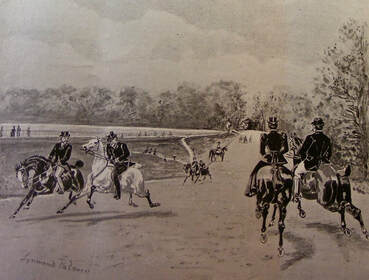
Before there was Central Park, with its miles of bridle paths and drives, avid equestrians and devotees of fast harness horses or slower moving carriages could travel the network of roads and farm lanes that meandered the length and breadth of Manhattan. Day-tripping on the Bloomingdale Road – with its grand vistas, hidden coves, inns, and taverns – was among the most popular pastimes for Manhattan’s riders and drivers. The opening of Central Park only added to the attraction of riding and driving the old roads, and as the city grew, the west side, in particular, became home to some of the most influential riding schools and clubs in the United States.
Judith Martin Woodall was the office manager of the Claremont Riding Academy for 27 years, and a recipient of the John H. Daniels Fellowship of the National Sporting Library and Museum for her project, “Witching the World With Noble Horsemanship: the Riding Schools of New York City."
Judith Martin Woodall was the office manager of the Claremont Riding Academy for 27 years, and a recipient of the John H. Daniels Fellowship of the National Sporting Library and Museum for her project, “Witching the World With Noble Horsemanship: the Riding Schools of New York City."
Monday, February 4, 2019 at 6:30pm, Ballroom of the Hostelling International NY
"East of Broadway in the 1950s: Growing Up Poor on West 105th Street"
"East of Broadway in the 1950s: Growing Up Poor on West 105th Street"
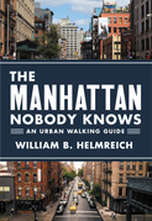
Presenter: William Helmreich, Distinguished Professor of Sociology at City College of New York and CUNY Graduate Center. Professor Helmreich is the author of 17 books, from his first book about living, working and traveling with the Black Panthers to his recently published The Manhattan Nobody Knows: An Urban Walking Guide
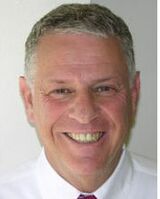
Dr. Helmreich, the child of Holocaust survivors, grew up in the 1950s on West 105th Street between Amsterdam and Columbus Avenues, alongside Puerto Rican, Black, Irish, and Italian families. He talked about the street life and culture, poverty, family life, barber shops, restaurants and bakeries, nearby movie theaters, public housing and area parks. He described his travels around the city with his father--how the two would play a game they called "Last Stop"--riding the subway to a stop and then walking around the new neighborhood. Helmreich said that these trips were the main impetus for his walking books about NYC.
Monday, January 14, 2019 at 630pm, Ballroom of the Hostelling International NY
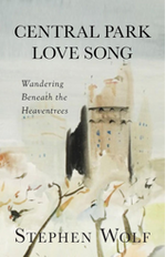
"Thought You Knew All about the Northern End of Central Park?"
Presented by Dr. Steven Wolf, author of Central Park Love Song: Wandering Beneath the Heaventrees, and moderated by local historian Jim Mackin
Dr. Wolf’s book is a blend of fact and fiction including excerpts from novels, poems, essays and songs about Central Park. The book’s narrator and his dog learn why the park is so large on an island so small, why it grows in the center of Manhattan and what in the park has been lost to the needs of an ever-changing city. For the January 14 program, Wolf focused on the Park’s northern end, bordering the Bloomingdale neighborhood. Writing in the NYTimes, Sam Roberts called Wolf’s book “an eloquent, evocative ode that encompasses New York history, past and contemporary protagonists, geography and botany so gracefully that reading his book is like, well, a walk in the park.”
Presented by Dr. Steven Wolf, author of Central Park Love Song: Wandering Beneath the Heaventrees, and moderated by local historian Jim Mackin
Dr. Wolf’s book is a blend of fact and fiction including excerpts from novels, poems, essays and songs about Central Park. The book’s narrator and his dog learn why the park is so large on an island so small, why it grows in the center of Manhattan and what in the park has been lost to the needs of an ever-changing city. For the January 14 program, Wolf focused on the Park’s northern end, bordering the Bloomingdale neighborhood. Writing in the NYTimes, Sam Roberts called Wolf’s book “an eloquent, evocative ode that encompasses New York history, past and contemporary protagonists, geography and botany so gracefully that reading his book is like, well, a walk in the park.”

Dr. Wolf teaches literature and humanities at Berkeley College and is the editor of I Speak of the City: Poems of New York (Columbia University Press). An excerpt about the park's notorious Casino appeared in The New York Times, and his city portraits and histories appeared regularly in The Villager. His fiction has been published in Playboy, Ploughshares, Shenandoah, Penthouse, and a short story cycle Intimate Articles with illustrations by Larry Rivers, published by TenSpeed Press.
Watch Video of this Presentation:
Watch Video of this Presentation:
Past Events of 2018
Tuesday, November 27, 2018 at 6:30 pm, Ballroom of the Hostelling International NY
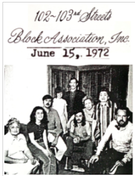
Bloomingdale Blocks/ How Block Associations Influenced and Improved our Neighborhood:
Moderated by Pam Tice, speakers included Mort Berkowitz who shared memories of his work at the Citizens Committee for New York City, which supported the development of block associations in the '70s. Along with Mr. Berkowitz, three current neighborhood block leaders, Nancy Macagno of the West 106th Block Association, Jean Jaworek of the North West Central Park Multiblock Association, and David Reich of the West 102-103 Block Association talked about their block associations in our neighborhood.
Watch Video of this presentation:
Moderated by Pam Tice, speakers included Mort Berkowitz who shared memories of his work at the Citizens Committee for New York City, which supported the development of block associations in the '70s. Along with Mr. Berkowitz, three current neighborhood block leaders, Nancy Macagno of the West 106th Block Association, Jean Jaworek of the North West Central Park Multiblock Association, and David Reich of the West 102-103 Block Association talked about their block associations in our neighborhood.
Watch Video of this presentation:
Thursday, November 15, 2018 at 6:30pm, Ballroom of the Hostelling International NYC
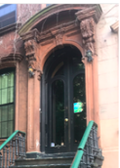
The Harlem Renaissance
William Seraile, Professor Emeritus of African-American history at Lehman College, CUNY, presented an illustrated talk on the remarkable flowering of African-American literature, art, music and theater in Harlem in the early 20th century
William Seraile, Professor Emeritus of African-American history at Lehman College, CUNY, presented an illustrated talk on the remarkable flowering of African-American literature, art, music and theater in Harlem in the early 20th century
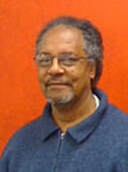
William Seraile is Professor Emeritus, Department of Africana Studies, Lehman College. He is the author of several scholarly articles and five books, the most recent of which is Angels of Mercy: White Women and the the History of New York's Colored Orphan Asylum.
Tuesday, October 16, 2018 at 6:30pm, the Ballroom of the Hostelling International NYC
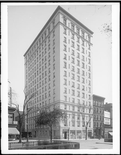
The Architects of Bloomingdale: An illustrated presentation by Jim Mackin and Gil Tauber about the architects who shaped our neighborhood and Presentation of the First Annual Jim Torain Award to Peter Salwen for the work he has done to honor the history of the Upper West Side
This presentation focused on the most influential architects in the Bloomingdale neighborhood from the end of the 19th century to the middle of the 20th--Richard Morris Hunt, Rosario Candela, Schwartz and Gross and others.
This presentation focused on the most influential architects in the Bloomingdale neighborhood from the end of the 19th century to the middle of the 20th--Richard Morris Hunt, Rosario Candela, Schwartz and Gross and others.
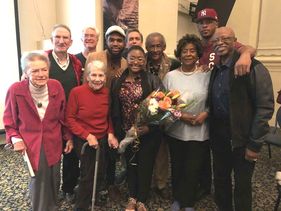 Friends and family of Jim Torain together with members of the BNHG planning committee
Friends and family of Jim Torain together with members of the BNHG planning committee
- Before the presentation began, the first annual JIm Torain award honored Peter Salwen. The Bloomingdale Neighborhood History Group established this award to honor the memory of Jim Torain, a neighbor who worked tirelessly to preserve the legacy of the "Old Community" where he grew up. The "Old Community" is the name given to the African American neighborhood that flourished on West 98th and West 99th Street between Central Park West and Columbus Avenue--a neighborhood that was destroyed in 1955 as part of the city's urban renewal plan. Without Torain’s work, the history of this vibrant neighborhood, once home of so many talented and accomplished people, may have been lost to time.
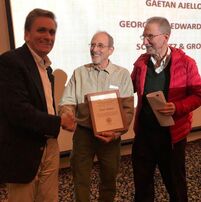
The 2018 Jim Torain Award honored Peter Salwen for the work he has done researching and sharing local history. Mr. Salwen's 1989 book Upper West Side Story continues to be the primary history of the Upper West Side in the three decades since its publication.
(photo on left: Jim Mackin and Gil Tauber of the BNHG presenting award to Mr. Salwen)
(photo on left: Jim Mackin and Gil Tauber of the BNHG presenting award to Mr. Salwen)
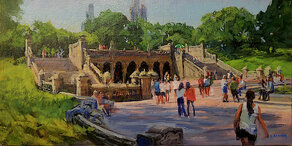 Summer Morning on Bethesda Terrace
Summer Morning on Bethesda Terrace
Peter Salwen is also a painter whose light-filled urban landscapes are in collections across the U.S., Europe and South America. His paintings "try to express the deep pleasure to be found in something as simple as sunlight on a wall or the ordinary traffic of people and machinery at city street corner." https://fineartamerica.com/profiles/peter-salwen.html
Thursday, September 27, 2018 6:30 PM, the Ballroom of the Hostelling International
|
John Tauranac spoke about the Upper West Side gems that he uncovered while researching his latest book: Manhattan's Little Secrets: Uncovering Mysteries in Brick and Mortar, Glass and Stone
Published by Globe Pequot Press http://www.globepequot.com/book/9781493030477 |
Tuesday, June 26, 2018 at 6:30pm at the Ballroom of the Hostelling International, NYC
Plants and People: How Central Park's Landscape is Evolving
Presenter: Regina Alvarez of the Central Park Floral Project
Ms. Alvarez, the former Director of Horticulture and Woodland Management at the Central Park Conservancy, shared her experience of the ecological restoration of Central Park's Woodlands and the recent findings of the Flora Project.
Presenter: Regina Alvarez of the Central Park Floral Project
Ms. Alvarez, the former Director of Horticulture and Woodland Management at the Central Park Conservancy, shared her experience of the ecological restoration of Central Park's Woodlands and the recent findings of the Flora Project.
Central Park Botanical Tour with Regina Alvarez Saturday morning, July 7, 2018
The Bloomingdale Neighborhood History Group organized a walking tour of woodlands in the northern part of Central Park, led by Regina Alvarez of the Central Park Floral Project. The tour was a companion event to her talk on June 26 entitled Plants and People: How Central Park’s Landscape is Evolving. On the walking tour, she generously shared her vast knowledge of the ecological restoration of the Central Park’s woodlands and answered a flood of questions about plants and their contexts. The route went around the Pool, along the Loch, and into the North Woods.
The Bloomingdale Neighborhood History Group organized a walking tour of woodlands in the northern part of Central Park, led by Regina Alvarez of the Central Park Floral Project. The tour was a companion event to her talk on June 26 entitled Plants and People: How Central Park’s Landscape is Evolving. On the walking tour, she generously shared her vast knowledge of the ecological restoration of the Central Park’s woodlands and answered a flood of questions about plants and their contexts. The route went around the Pool, along the Loch, and into the North Woods.
Thursday May 24, 2018

Exhibit and tour 1pm or 230pm
560 W 133rd St.(Nash Building East of Broadway)
560 W 133rd St.(Nash Building East of Broadway)
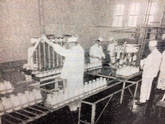
Columbia University provided a lecture and guided tour of the Manhattanville area that illustrated the rich history of the area, particularly the role the area played in the pasteurization of the area's milk supply, ending the scourge of childhood mortality caused by tainted milk.
Learn more at http://manhattanville.columbia.edu/about/history
Learn more at http://manhattanville.columbia.edu/about/history
Thursday, April 19, 2018 at the Ballroom of Hostelling International NYC
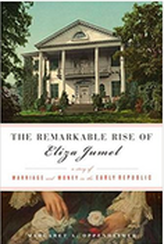
"Madame Jumel Collects: the Pioneering Art Collection of Rags-to-riches New Yorker Eliza Jumel"
A presentation by art historian Margaret Oppenheimer.
Ms. Oppenheimer, author of The Remarkable Rise of Eliza Jumel: A Story of Marriage and Money in the Early Republic, discussed Mme. Jumel’s art collection--over 240 paintings acquired in Paris at the beginning of the 19th century.
A presentation by art historian Margaret Oppenheimer.
Ms. Oppenheimer, author of The Remarkable Rise of Eliza Jumel: A Story of Marriage and Money in the Early Republic, discussed Mme. Jumel’s art collection--over 240 paintings acquired in Paris at the beginning of the 19th century.
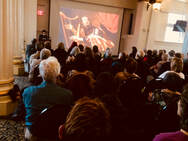
The amazing Eliza Jumel--raised in a brothel, indentured as a servant, and confined to a workhouse while her mother was in jail--rose to become one of the richest women in New York. Along the way, she turned herself into an art connoisseur, acquiring more than 240 paintings while living in Paris between 1815 and 1817. The largest assemblage of European art to reach these shores up to that time, the collection, soon dispersed, remains virtually unknown today. In this richly illustrated lecture, Ms. Oppenheimer brought Jumel’s pioneering collection back to life, discussing the paintings, their owner, and the early nineteenth-century art scene in New York and Paris.
Monday, March 19, 2018 at the Ballroom of Hostelling International NYC
Sculptures in the Bloomingdale Neighborhood:
The Artists Who Made Them, the People Who Posed for Them and the Stories They Tell
A presentation by local historian Jim Mackin
The Artists Who Made Them, the People Who Posed for Them and the Stories They Tell
A presentation by local historian Jim Mackin
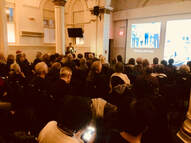
Renowned for his NYC walking tours https://www.weekdaywalks.com, Mr Mackin described the sculptures that grace the Upper West Side’s Bloomingdale neighborhood, and shared stories and history of the artists and their models. He called particular attention to Audrey Munson who modeled for over a hundred statues in the city, as well as the "Walking Liberty" half dollar. Jim pointed out the contributions of the Piccirilli Brothers, marble carvers who produced sculpture works throughout New York City, as well as French's statue of Lincoln in the Lincoln Memorial in Washington.
Read Marjorie Cohen's BNHG blog about Audrey Munson at The Rise and Tragic Fall of a Model Who Broke the Rules
Watch Video of this presentation
https://www.youtube.com/watch?v=DBRlb42RHdU
Read Marjorie Cohen's BNHG blog about Audrey Munson at The Rise and Tragic Fall of a Model Who Broke the Rules
Watch Video of this presentation
https://www.youtube.com/watch?v=DBRlb42RHdU
Tuesday, February 27, 2018 at the Ballroom of Hostelling International NYC
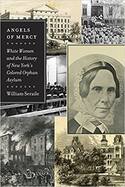
The History of New York's Colored Orphan Asylum
presented by Dr. William Seraile, Professor Emeritus at Lehman College, CUNY. Dr. Seraile taught African American history for 36 years and is the author of several books including Angels of Mercy: White Women and the History of New York's Colored Orphan Asylum.
presented by Dr. William Seraile, Professor Emeritus at Lehman College, CUNY. Dr. Seraile taught African American history for 36 years and is the author of several books including Angels of Mercy: White Women and the History of New York's Colored Orphan Asylum.
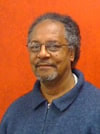 Dr. William Seraile
Dr. William Seraile
Founded by a group of affluent white women in 1836, the Asylum sheltered and educated thousands of African-American children. After its original building was destroyed by a white mob in the 1863 Draft Riots, a new one was built at 143rd street and Amsterdam Avenue. Dr. Seraile talked about how the organization's history sheds light on the changing conditions of African Americans in NY from the abolition of slavery in 1827 through the mid 20th century.
Read Dr. Seraile's summary of his presentation at New York's Colored Orphan Asylum
Read Dr. Seraile's summary of his presentation at New York's Colored Orphan Asylum
Wednesday, January 17, 2018 at the Ballroom of Hostelling International NYC
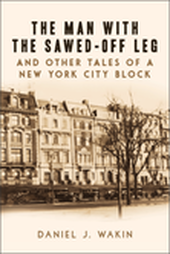
Author Daniel J. Wakin Book Talk:
The Man with the Sawed-off Leg and Other Tales of a New York City Block
In The Man with the Sawed-off Leg and Other Tales of a New York City Block Daniel J. Wakin tells the fascinating history of seven Beaux Art townhouses on Riverside Drive between 105th and 106th Streets – an "only if the walls could talk" kind of tale. Residents of the homes were among the most famous New Yorkers of their time: Marian Davies; Duke Ellington; the Fabers of pencil factory fame; Lucretia Davis, heir to the baking powder fortune; two mayors; lots of gangsters and more. The title refers to the unfortunate fate of a gangster who was shot in the leg in the course of an armored car robbery and died in one of the townhouses that his gang was using as a safe house. Mr. Wakin talked about the history of the seven townhouses and reflected on what their stories tell us about New York City and especially the Upper West Side. Read an excerpt from this presentation at The Man with the Sawed-off Leg
Read Marjorie Cohen's interview with Mr. Wakin for the website Brick Underground:
https://www.brickunderground.com/live/uws-dan-wakin-seven-beauties-book
The Man with the Sawed-off Leg and Other Tales of a New York City Block
In The Man with the Sawed-off Leg and Other Tales of a New York City Block Daniel J. Wakin tells the fascinating history of seven Beaux Art townhouses on Riverside Drive between 105th and 106th Streets – an "only if the walls could talk" kind of tale. Residents of the homes were among the most famous New Yorkers of their time: Marian Davies; Duke Ellington; the Fabers of pencil factory fame; Lucretia Davis, heir to the baking powder fortune; two mayors; lots of gangsters and more. The title refers to the unfortunate fate of a gangster who was shot in the leg in the course of an armored car robbery and died in one of the townhouses that his gang was using as a safe house. Mr. Wakin talked about the history of the seven townhouses and reflected on what their stories tell us about New York City and especially the Upper West Side. Read an excerpt from this presentation at The Man with the Sawed-off Leg
Read Marjorie Cohen's interview with Mr. Wakin for the website Brick Underground:
https://www.brickunderground.com/live/uws-dan-wakin-seven-beauties-book
Past Events of 2017
November 28, 2017 at the Ballroom of Hostelling International NYC
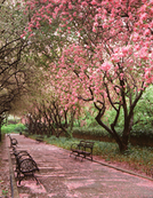
"Northern Exposure: Central Park above 96th Street"
A Presentation by Sara Cedar Miller,
Historian and Photographer, Central Park Conservancy
Ms. Miller spoke about the Park's topography and history – its connection to the Dutch and English occupation, the Revolutionary War and the War of 1812, including the fascinating story of the Park cannon's true identity. Read Pam Wise's blog on this presentation at Northern Exposure
A Presentation by Sara Cedar Miller,
Historian and Photographer, Central Park Conservancy
Ms. Miller spoke about the Park's topography and history – its connection to the Dutch and English occupation, the Revolutionary War and the War of 1812, including the fascinating story of the Park cannon's true identity. Read Pam Wise's blog on this presentation at Northern Exposure
October 4, 2017 at the Ballroom of Hostelling International NYC

"HISTORY OF HOSTELLING INTERNATIONAL NYC"
Featured presentations by HI NYC’s Community Engagement staff: Manager Emily Gallagher and Coordinators Ben Puterbaugh and Indigo Goodson. Pam Tice, former Executive Director of HI NYC, and volunteer historian, provided a history of the building from the days when it served as the "Association Residence for the Relief of Respectable Aged Indigent Females."
Read Pam Tice's blog on the history of the Hostel's building and how it became a landmark at The Story of 891 Amsterdam.
Featured presentations by HI NYC’s Community Engagement staff: Manager Emily Gallagher and Coordinators Ben Puterbaugh and Indigo Goodson. Pam Tice, former Executive Director of HI NYC, and volunteer historian, provided a history of the building from the days when it served as the "Association Residence for the Relief of Respectable Aged Indigent Females."
Read Pam Tice's blog on the history of the Hostel's building and how it became a landmark at The Story of 891 Amsterdam.
June 6, 2017 at the Ballroom of Hostelling International NYC
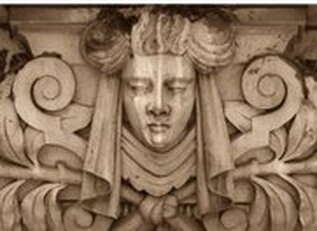
"Figures in Stone: The Wonderful (and often unnoticed) Building Sculptures of the Upper West Side"
This program featured a presentation by architect Robert Arthur King, FAIA, a passionate observer and photographer of NYC building sculpture. Mr. King put the program together especially for an Upper West Side audience featuring sculptures on buildings from West 72nd to West 110th Street. His talk was preceded by Stonefaced, an excellent short film by Vivian Ducat that focused on Mr. King’s decades-long fascination with the subject. A Q&A with Mr. King and Ms. Ducat followed the presentation. Mr King is author of Figures in Stone: Architectural Sculpture in New York City
This program featured a presentation by architect Robert Arthur King, FAIA, a passionate observer and photographer of NYC building sculpture. Mr. King put the program together especially for an Upper West Side audience featuring sculptures on buildings from West 72nd to West 110th Street. His talk was preceded by Stonefaced, an excellent short film by Vivian Ducat that focused on Mr. King’s decades-long fascination with the subject. A Q&A with Mr. King and Ms. Ducat followed the presentation. Mr King is author of Figures in Stone: Architectural Sculpture in New York City
May 16, 2017 at Trinity School, 101 West 91st Street
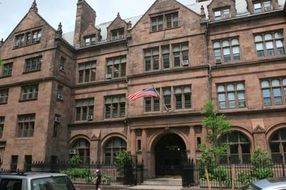
"Trinity School from 1709 to 2017"
“Behind the Scenes” Event sponsored by the BNHG
The history of the Trinity School, founded at downtown Trinity Church in 1709 and now one of the oldest schools in the US. In 1895, the school moved uptown, building on a series of lots on West 91st Street in the midst of rows of townhouses in turn-of-the-century Upper West Side. The school evolved from church-sponsored to ecumenical, from a charity school to a private school, from all-boys to co-educational and to a school that prides itself on its diverse student body.
“Behind the Scenes” Event sponsored by the BNHG
The history of the Trinity School, founded at downtown Trinity Church in 1709 and now one of the oldest schools in the US. In 1895, the school moved uptown, building on a series of lots on West 91st Street in the midst of rows of townhouses in turn-of-the-century Upper West Side. The school evolved from church-sponsored to ecumenical, from a charity school to a private school, from all-boys to co-educational and to a school that prides itself on its diverse student body.
April 17, 2017 at 630pm, the Ballroom of Hostelling International-NYC
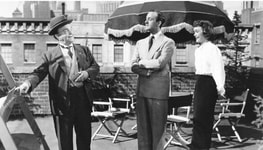
"Movies Filmed in Bloomingdale: Why Hollywood Likes Our Neighborhood"
Featured Gary Dennis--former actor, owner of the Upper West Side's beloved "Movie Place", tour guide and, according to the NY Times, "film scholar without portfolio" --along with Jim Mackin, local historian and frequent BNHG program presenter
Films included: Trading Places/Little Murders/Seven-Ups/Bullets Over Broadway/Who's That Girl/Warriors
Featured Gary Dennis--former actor, owner of the Upper West Side's beloved "Movie Place", tour guide and, according to the NY Times, "film scholar without portfolio" --along with Jim Mackin, local historian and frequent BNHG program presenter
Films included: Trading Places/Little Murders/Seven-Ups/Bullets Over Broadway/Who's That Girl/Warriors
March 1, 2017 at 630pm, the Ballroom of the Hostelling International-NYC
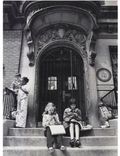
"From House to School: The History of Bloomingdale School of Music:
Building Community Through the Power of Music for 52 Years"
A Presentation by Erika Floreska, Executive Director
Memories and Historical Photos
With a Musical Presentation by Current Students
Building Community Through the Power of Music for 52 Years"
A Presentation by Erika Floreska, Executive Director
Memories and Historical Photos
With a Musical Presentation by Current Students
January 23, 2017 at 630pm, the Ballroom of Hostelling International-NYC
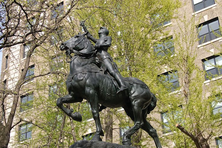
"Sculptures in the Bloomingdale Neighborhood: The Artists Who
Made Them, The People Who Posed for Them, and the Stories They Tell"
A Presentation by Local Historian Jim Mackin
Jim Mackin, well-known for his walking tours http://www.weekdaywalks.com/ that cover just about every neighborhood in NYC, shared little known details about the various sculptures that grace the Upper West Side's Bloomingdale neighborhood. He shared stories about the sculptors who made them--some of the most famous artists of their time-- and the models who posed for them – including Audrey Munson, of whom Daniel Chester French wrote: “I know of no other model with the particular style that Miss Munson possesses. There is a certain ethereal atmosphere about her that is rare.”
Mr. Mackin explained the history that surrounds the sculptures and how they came to be located on the Upper West Side. His presentation included statues in Riverside Park and Straus Park; some that adorn the interiors of Riverside Church and St. John the Divine; and one that stands as the centerpiece of Frederick Douglass Circle.
Watch VIDEO of this presentation:
Made Them, The People Who Posed for Them, and the Stories They Tell"
A Presentation by Local Historian Jim Mackin
Jim Mackin, well-known for his walking tours http://www.weekdaywalks.com/ that cover just about every neighborhood in NYC, shared little known details about the various sculptures that grace the Upper West Side's Bloomingdale neighborhood. He shared stories about the sculptors who made them--some of the most famous artists of their time-- and the models who posed for them – including Audrey Munson, of whom Daniel Chester French wrote: “I know of no other model with the particular style that Miss Munson possesses. There is a certain ethereal atmosphere about her that is rare.”
Mr. Mackin explained the history that surrounds the sculptures and how they came to be located on the Upper West Side. His presentation included statues in Riverside Park and Straus Park; some that adorn the interiors of Riverside Church and St. John the Divine; and one that stands as the centerpiece of Frederick Douglass Circle.
Watch VIDEO of this presentation:
Past Event of 2014
November 19, 2014 at 630pm, the Ballroom of the Hostelling International-NYC
Hospitals and Healing on the Upper West Side
| bnhg_chronology_of_events_2000-2017.xlsx | |
| File Size: | 37 kb |
| File Type: | xlsx |
An Excel file of all BNHG events from 2000 to 2017

